
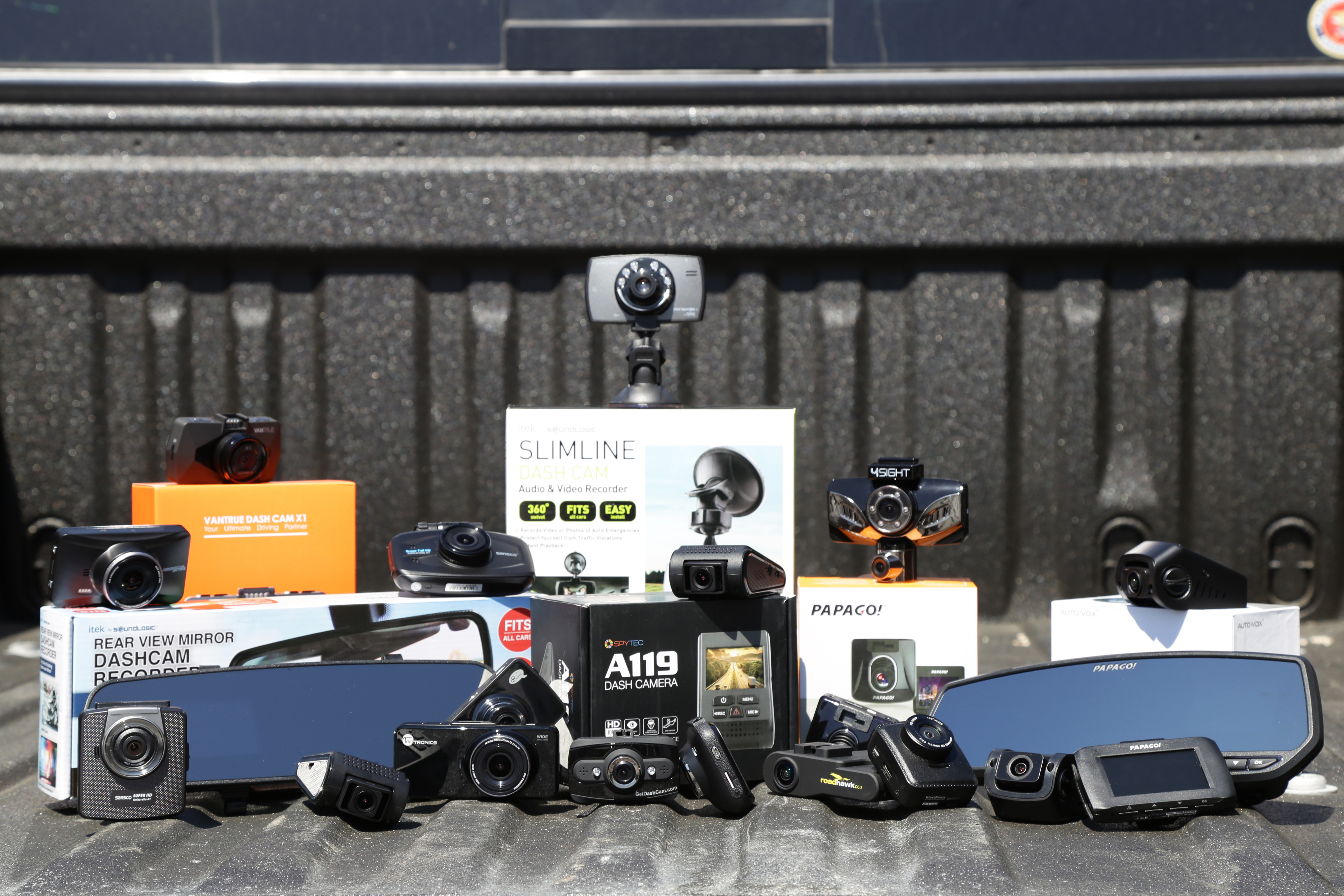
Dash cameras aren’t new to the scene, but they are one aftermarket auto electronic that manufacturers haven’t successfully integrated into production yet. Backup cameras, higher-quality audio, and media displays all started as aftermarket add-ons that have since found their way into the majority of new cars as at least options—if not standard features for some— today.
We’ve taken a look at a handful of dash cameras before, and since there are thousands of them we decided to round up a few of the more popular models and create a guide for anyone wanting a more in-depth look at the models before they buy.
Dash camera styles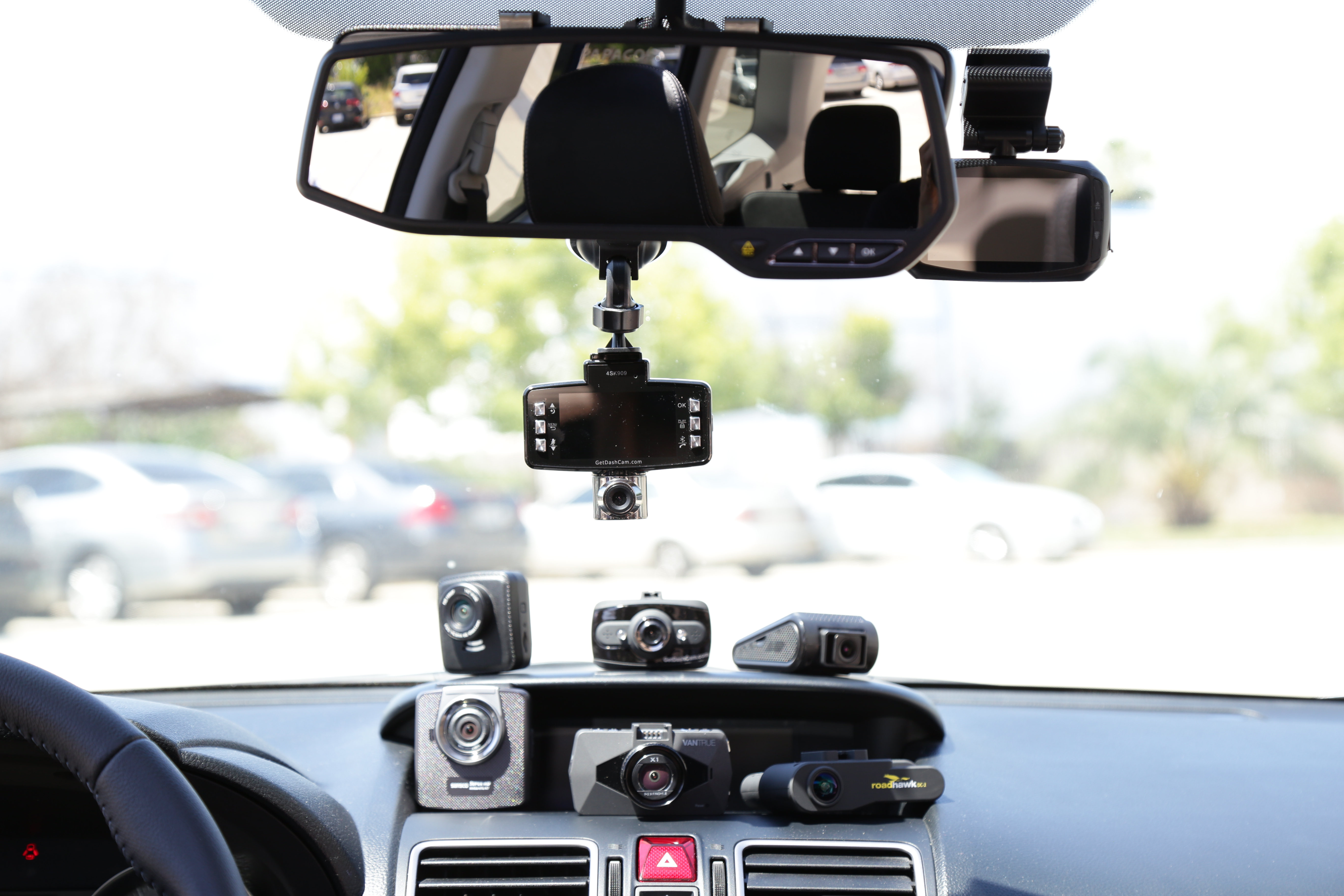
There are 3 main physical styles of dash cams, which we refer to as the “hanging”, “wedge”, and “mirror” styles. Each has slightly different characteristics in use, but the physical appearance is large.
The most common type is the the “hanging” style. This style is a windshield suction cup or adhesive-mounted model that is either a square, rectangle, cylinder (or some variation), which hangs down and can be rotated in different angles. The ability to remove or redirect the unit easily makes for switching between vehicles easy, and the adjustments for viewing based on placement or camera angle are simple to update.
The next style is the “wedge”. This form is generally more compact than either the “hanging” or “mirror” style, (with some exceptions of small “hanging” styles) and is fixed upon the windshield with adhesive tape and sometimes a simple mount, which often can be removed to get better access to the controls. The downside of the adhesive mount is that they are more difficult to remove, and cannot be easily shifted around. For those looking to have the most low-key placement on the windshield, this is generally the best option. Since the small form factor is common, often times the navigation through the menu is more difficult as buttons tend to be smaller and fewer. When attempting to make quick settings changes, it isn’t the most convenient since the angle dictates a hunched posture to see the screen.
Finally, we have the “mirror” style. The mirror style has a screen embedded in the viewing surface of the rear-view mirror, which clips over the stock mirror. The camera usually hangs on the back side and is not as large as some of the other camera styles. The camera can be rotated around to get the correct FOV, however often times there is a skewed perspective since the camera is not on-center. Another downside is if you have a mirror with directional displays, emergency assistance, or programmable buttons these are often covered up. The benefit is often that this is the most discrete implementation for a dash cam, and when the screen is turned off operates just like a normal mirror. Some states have laws against objects hanging from the rear view mirror or attaching them to the windshield, so it is advised to check local regulations before purchasing.
Specs that matter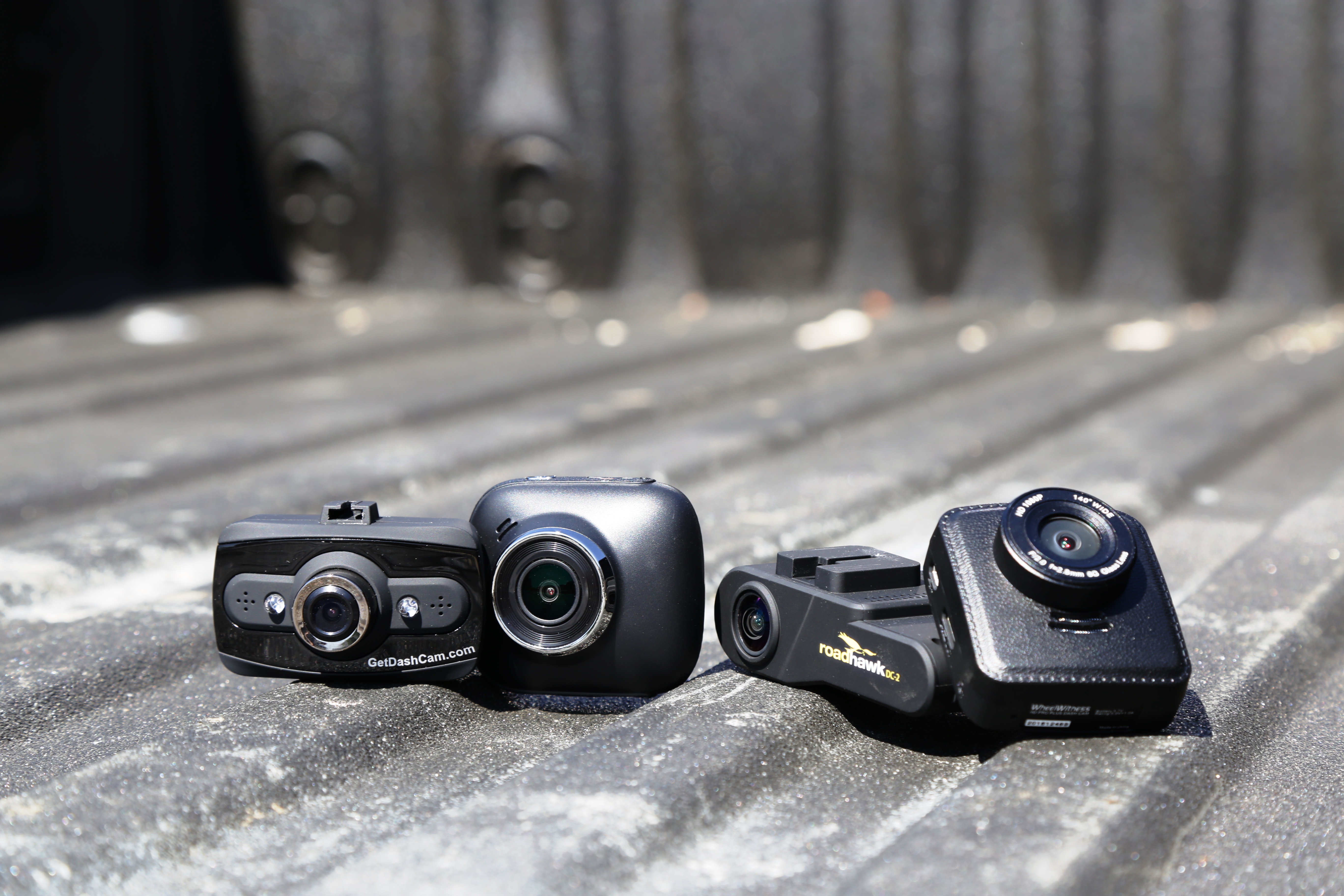
There are a few different specs that should be taken into account when looking at dash cameras, however the importance of each is really dependent on the user. One of the most critical is the field of view (FOV), which will determine how much of the front end/fender areas of the vehicle are within the camera’s line of sight. This is important to note as the more coverage that a camera has the more protection it can offer. Often times the events leading up to an accident are not directly in front of the vehicle involved.
Another very important spec to note when choosing a dash cam is the image quality and adjustments available. Most dash cameras now are advertised at 1080p, and some are even 2K or 4K. It should be noted though that often times manufacturers will inflate their calculations just to slap a higher resolution on the box, so when available try to obtain footage from the unit before purchasing it. The resolution and overall quality should be decent enough to make out license plates and street signs in all lighting conditions, however beyond that is at the user’s discretion. Many cameras have adjustments for exposure compensation, white balance, sharpness, and WDR (wide dynamic range) is popular for capturing details in shadows and adverse lighting conditions.
Other factors to consider are the physical style and size of the unit, which is entirely preference based on the user’s application and wants. Additional features that are often included in dash cam specs are rear-facing cameras, GPS location, speed data, microphone recording, motion detection, and others that may or may not be relevant, depending on the user.
What we look for in a dash cam
What we personally like to see in a dash camera is pretty much just the basics. A solid FOV, good picture quality at day and night with WDR, and a small form factor to take up as little space on the windshield as possible. An intuitive interface is always nice to have, but utility over everything else is the preference here. In our opinion it should work great when called upon, and be something out of sight and out of mind when not needed.
When looking at these we didn’t adjust the video settings before recording footage, instead opting for out of the box performance to get a feel for how they run on factory settings (all were set to their highest resolution by default). Most models have image adjustments for exposure, and some even offer additional white balance options, but for the sake of across the board visibility in day and at night these were not calibrated individually. All dash cams tested also have the standard features for dash cams (G-sensor recording, automatic locking emergency events to protected memory, and automatic recording upon vehicle power).
It should also be noted that there are an increasing amount of dash cameras now that are coming with HDMI outlets, as well as motion detection recording. The overall utility of these functions can be debated, but in our experience they were not of high importance to the functionality of the device in our average use case.
Dash cam selection
Old Shark GS505 – $49.99
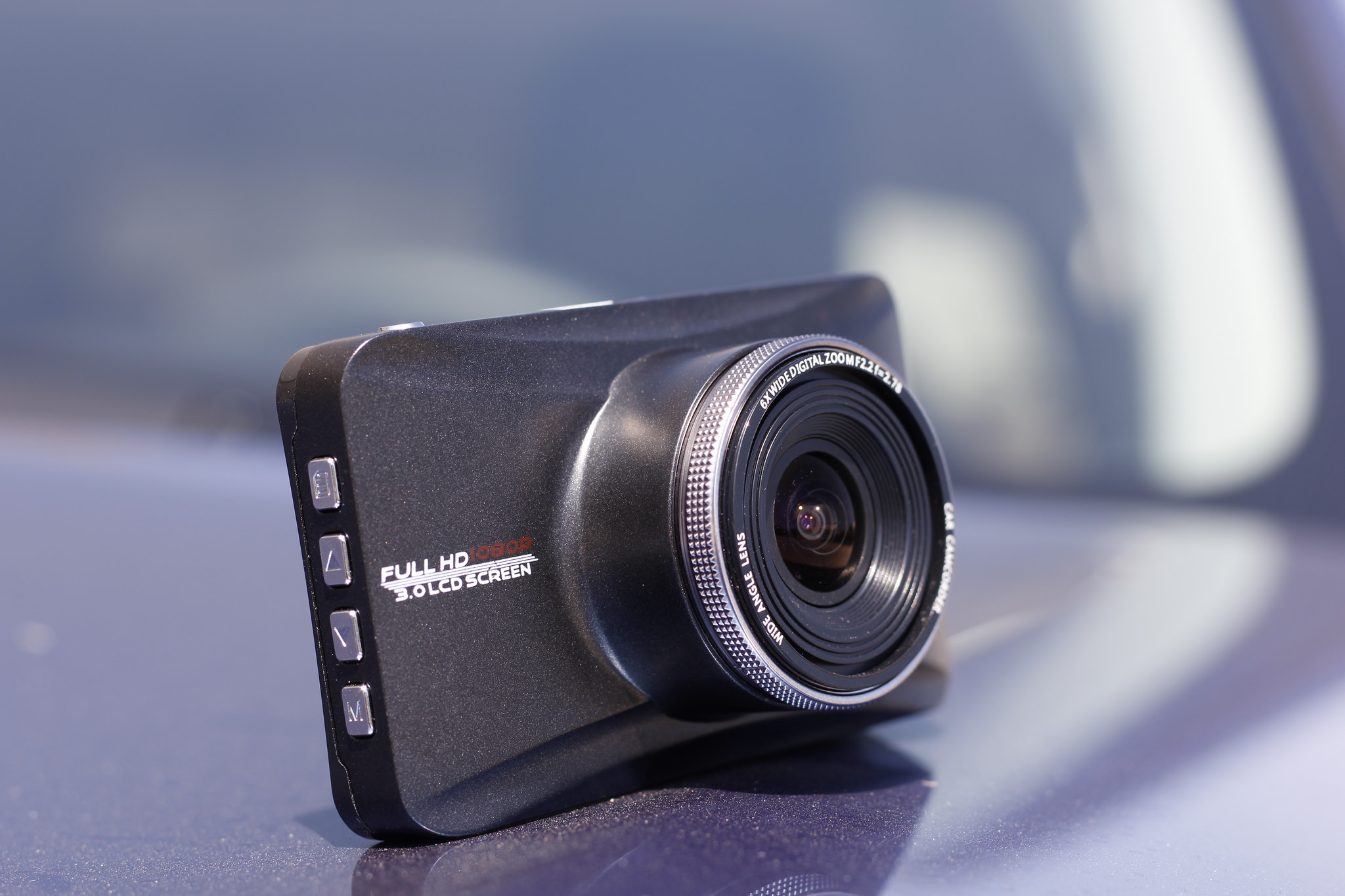
- Night Vision
- 170° FOV
- 3″ Screen
- Parking Guard
- 32GB micro SD card
With a 3” screen, the Old Shark GS505 is on the larger side of our dash cam round up. The large screen size is appropriate given that the lens has 6x wide digital zoom, which we find useful for zooming in on license plates if needed. All but one button can be found on the left and right side of the camera, while the power button stands alone on the top edge making it easy to avoid accidently presses when moving through the interface or zooming in/out.
When recording in daylight, the GS505’s 1080p and 170° wide angle lens shine through in the image quality. We can easily see license plates about 10-15 feet away, even on lanes to the left or right of the car. For nighttime driving, the video quality is still great but the camera captures the best video when the focus is directly in front of the car. We think the wide angle lens hurts the camera here as the left and right lanes because very dark unless lit up by street lights.
QQLink Owl Eye- $65.99
- 1080p
- WDR
- 140° FOV
- 2.4” LCD
- IR filter
- 5 level adjustable EV
- CMOS low illumination level sensor
The Owl Eye is one of the mid-sized units, with a mid-sized screen. They could have gone smaller with the design to shrink it down overall, which we believe they should have, but the button placement is nice, and navigation is simple even with only 3 buttons. The unit is pretty sleek overall, and has a decent weight to it.
The daylight recording is very good, and details are easy to pick out without much effort. The FOV is solid as well, which gives plenty of visibility to the front end of the vehicle. The nighttime recording is not quite as impressive, as it seems that the camera only picks up the center of the headlight beam with great clarity in dark areas. Visibility is better with other lighting sources, and in this scenario it works well to show peripheral activities.
QQLink Eagle Eye- $99.95
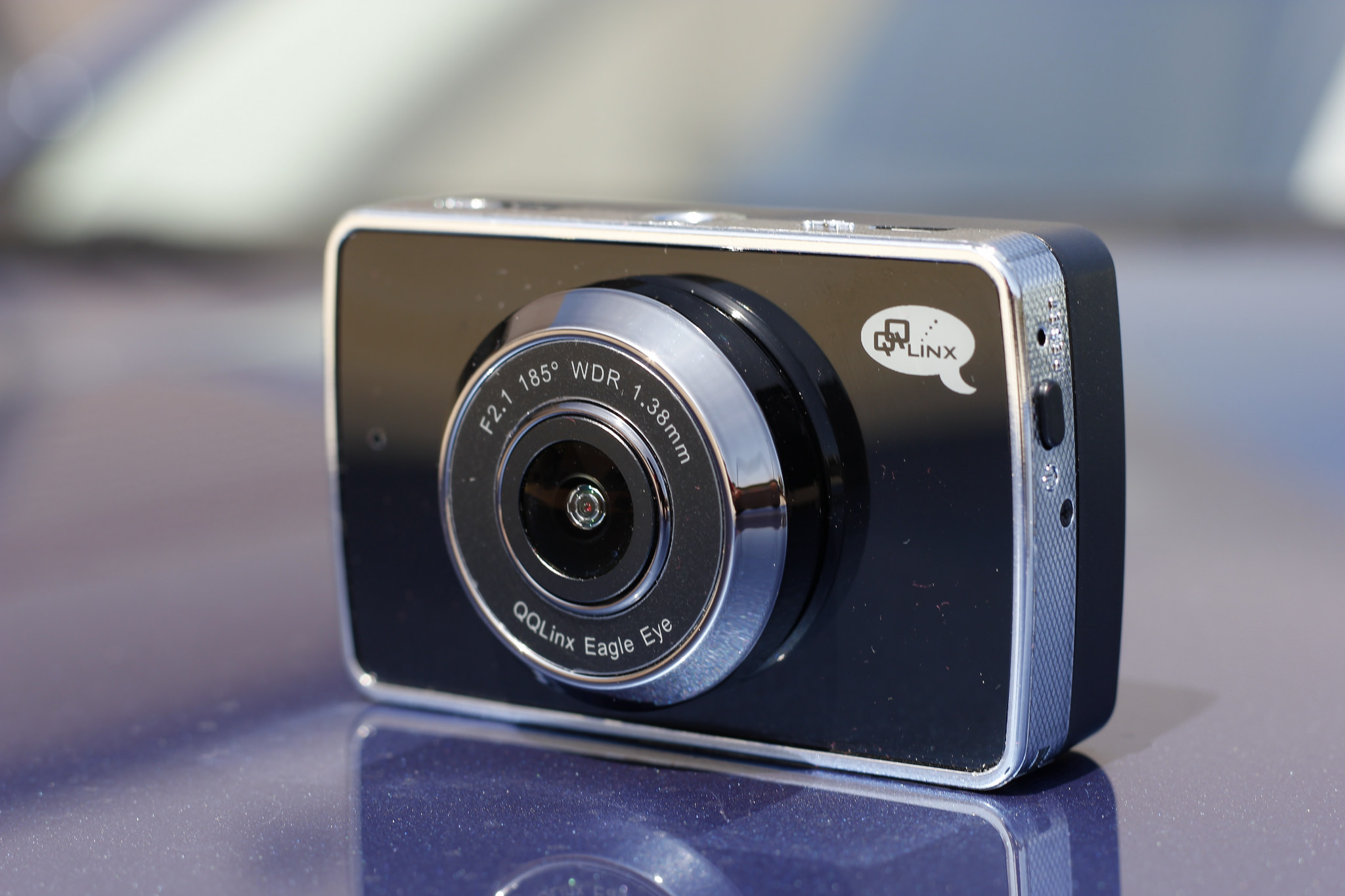
- 185° FOV
- Sony Exmor Sensor
- Hit & Record (Patent Technology)
- 1080p
- WDR
- Heat-resistant 6G lens
- Parking mode
- 2.4” LCD
The Eagle Eye Ultimate Crystal dash cam sports a 2.4” LCD screen and only has four pressable buttons – a power button and three other buttons to help maneuver through the camera’s interface. The screen quality seems to be on the low end so playback on the actual camera will not show any license plates or street signs in readable detail. The camera itself feels a tad light with all the features packed into it.
Exporting the video shows off the 185° extra wide FOV, and in our setup, the side mirrors are even in the video! Videos in the daylight look great, but did not look like 1080p quality. We think the wide angle lens hurts the camera as shots of palm trees and the objects in the horizon look great, but details like license plates or billboard signs are hard to read. Nighttime videos have similar flaws that we experienced in the daytime videos, but with even less details are found since the camera has a hard time capturing enough light. Honestly, this dash camera seems better suited for road trips with spectacular views or capturing an overall road incident rather than seeing the finer details because the video quality doesn’t look or feel like 1080p.
QQLink Hawk Eye- $75.99
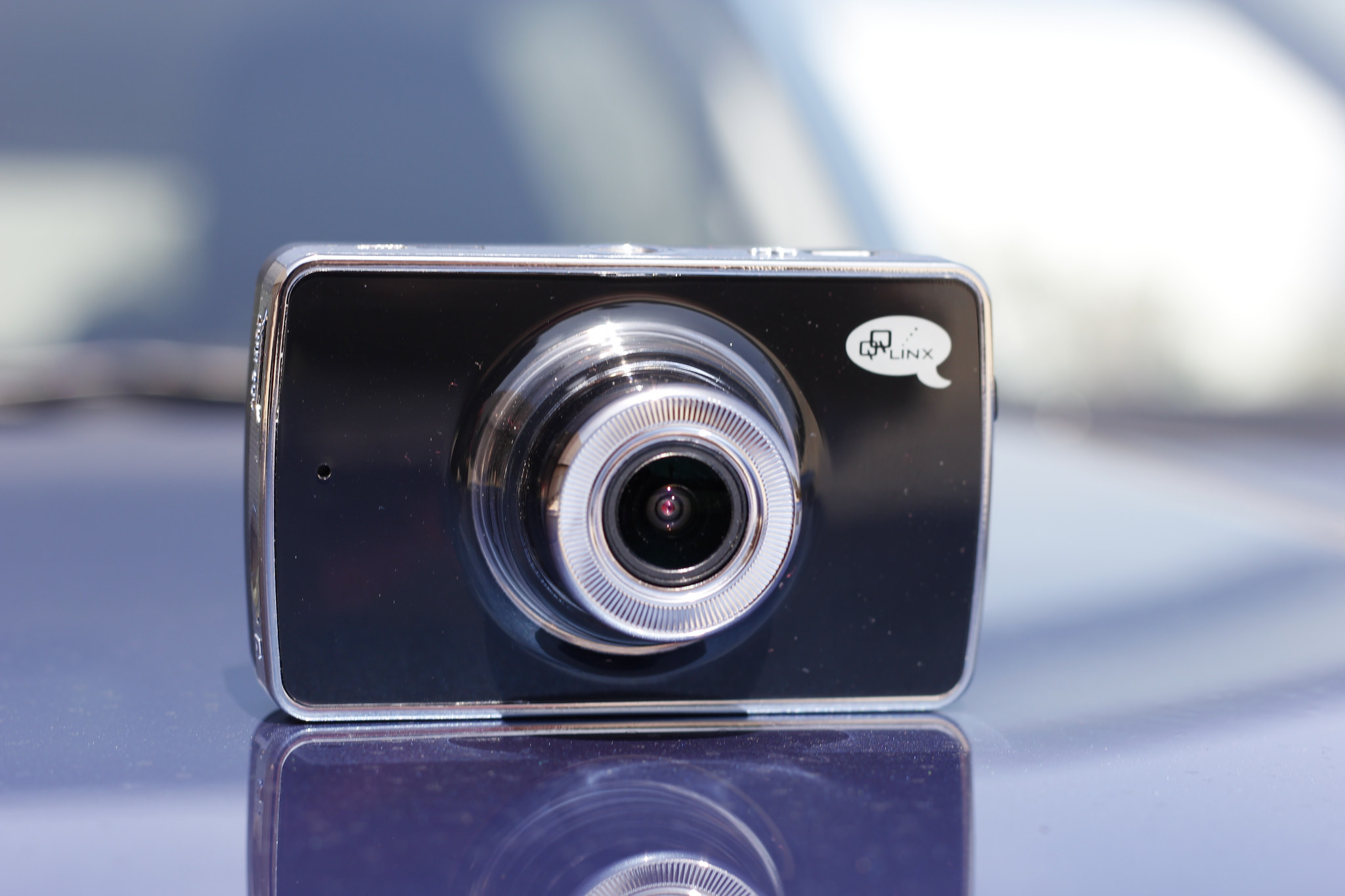
- 1080p
- WDR
- Heat-resistant 6G lens
- 140° FOV
- Parking Mode
Side by side, QQLinx’s Eagle Eye and Hawk Eye look very similar in terms of style such as the simple four button interface, 2.4” LCD screen, and light-plastic feel. Besides the FOV, the biggest difference between the Eagle Eye and Hawk Eye is how much longer the Hawk Eye’s lens extends, making it less compact to it’s pricier brother. Also, the interface is the same between the two QQLinx, and with only four buttons, is very simple to use.
During daytime driving, the Hawk Eye’s 140° wide angle lens captures details almost to the very sides of the car without having too much of a curved “fish-eye” effect compared to the 185° lens on the Eagle Eye. Details in license plates and signs are visible when there’s enough light, but the video quality deteriorates as those same details are much harder to see. Overall the camera captures the scene well, although it could be improved to enhance the finer details.
Wheel Witness HD PRO- $99.99
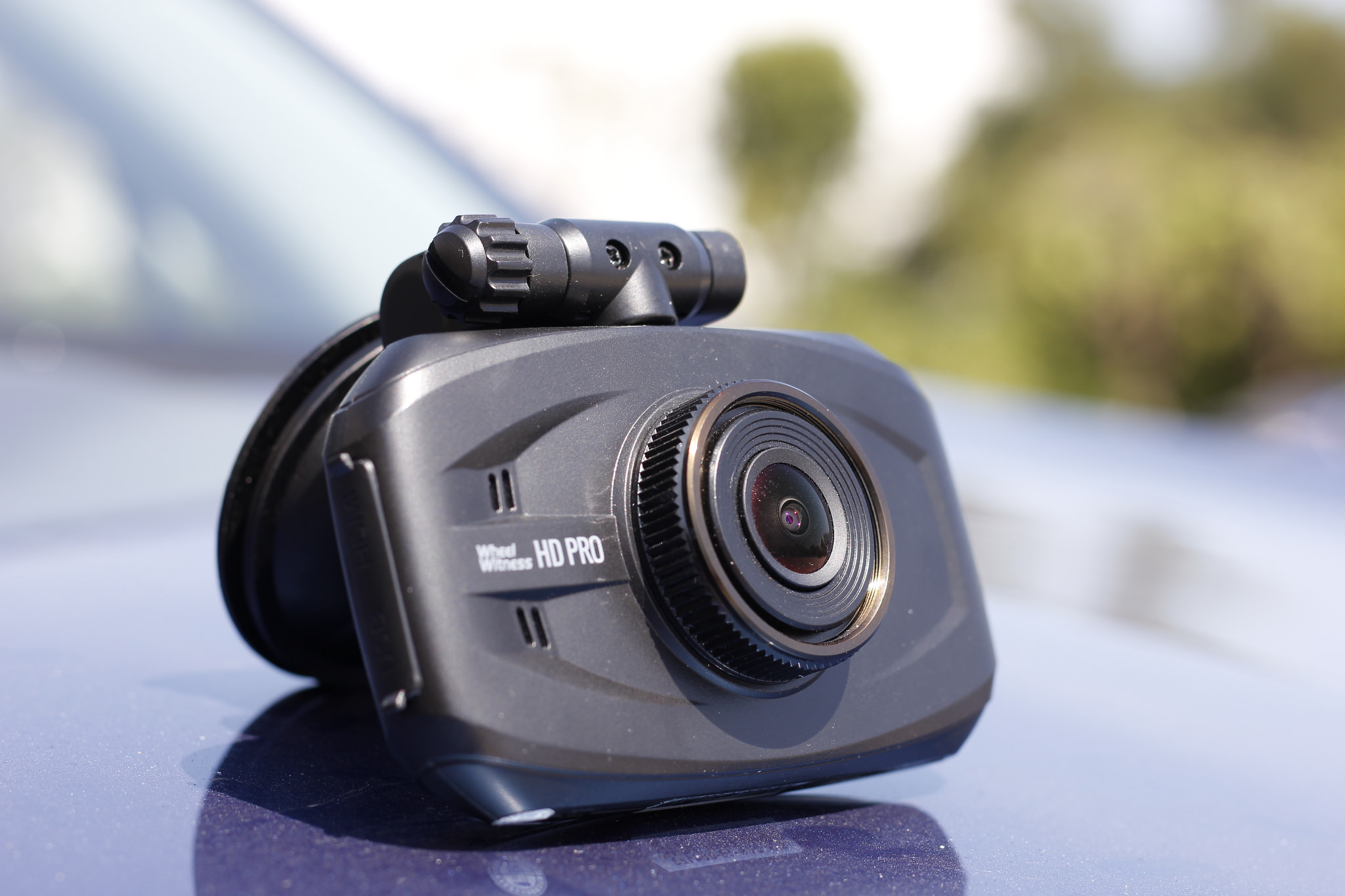
-
-
- 16GB microSD Card w/ USB Adapter
- High End Ambarella A7LA50 + Omnivision OV4689
- 3 Mounts for Multiple Vehicles
- GPS
- 170° FOV
- Night vision
-
Wheel Witness’s HD Pro is a slim and discreet dash camera packed that boasts features found in higher priced models. The camera itself is attached to part of the mounting system that houses the GPS module which then attaches to a suction cup or 3M sticky pad. We found using this device while attached is easy as cake with the large 3” LCD screen and accessible buttons that face the driver.
The Wheel Witness HD Pro almost has a 2K resolution at 2304×1296 @ 30fps and with the 170° FOV, this camera shines in both daytime and nighttime recording. Daytime recordings were clear and the FOV captured cars, people, the reflection off the hood, or objects on either side of the car, but street signs were hard to read when stopped at a light. The nighttime videos were impressive in terms of capturing the environment in low lighting – even if objects were out of the headlight beams. We think this camera is great for recording incidents or landscapes, but finer details could be improved to make this one of the best dash cameras.
Wheel Witness HD PRO PLUS- $124.99
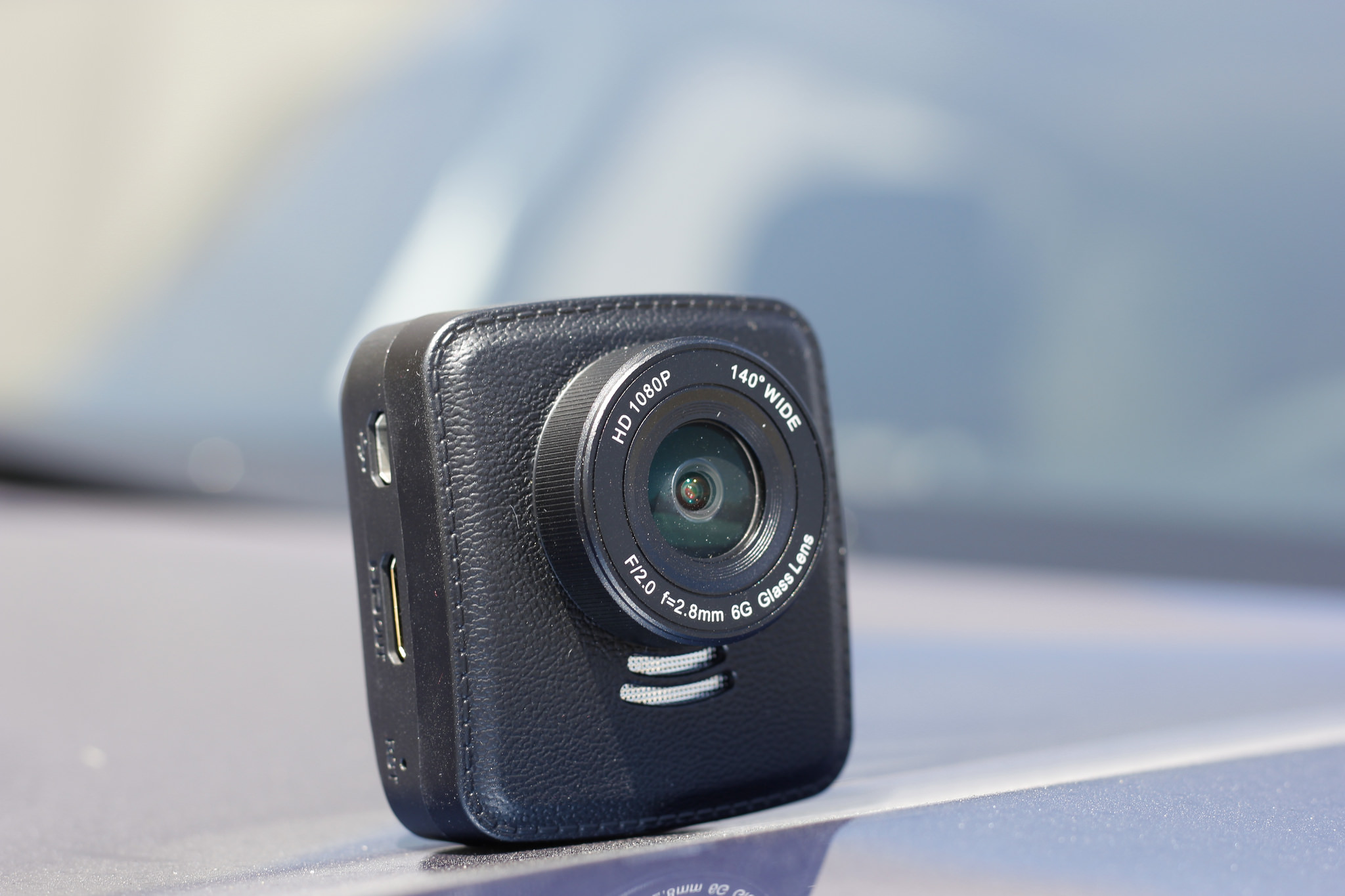
-
-
-
-
- 1080p
- 140° FOV
- GPS
- F/2.0 f=2.8
- iOS/Android playback
-
-
-
The form factor on the HD PRO PLUS is compact, and well-designed. The button placement makes navigation easy, without seeming to add to the overall size. The lens takes up about half the height of the unit, and we are fans of the compact nature of this unit. It comes off as simplistic without being stripped down, and easy to use.
The video quality on the HD PRO PLUS was excellent during the day, with detail and reflections captured very clearly. The night visibility of the unit was also very good, and not only the headlight beams but really the entire road was illuminated with the stock settings. License plate visibility did suffer at night though, as they showed up washed out in the compensated setting. The quality of the camera is there though, and we think with a few tweaks a great balance could be found for a solid overall camera.
AUTO-VOX D1- $69.99
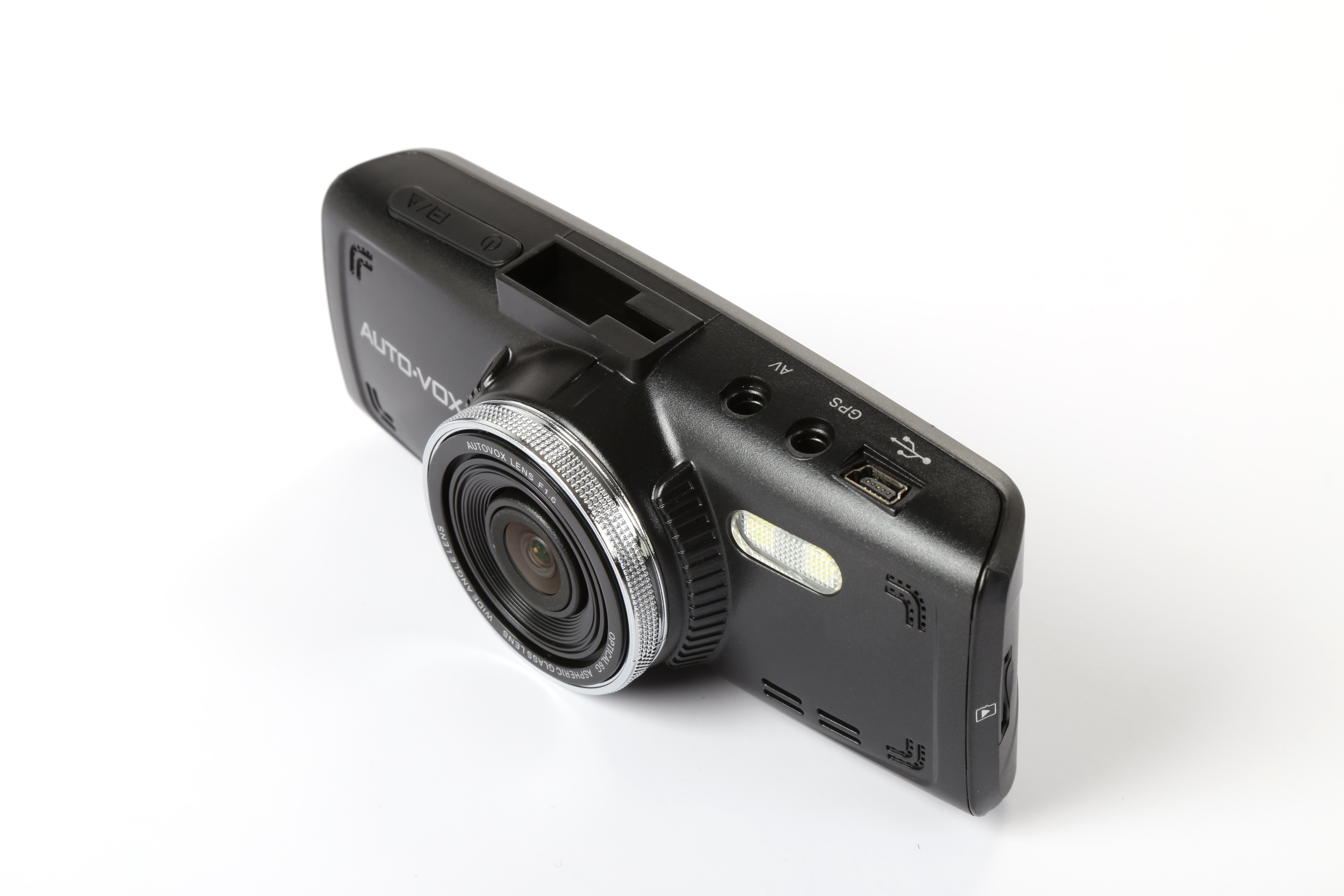
-
-
-
-
- 1080p
- 2.7” LCD
- F1.6
- WDR
- 140° FOV
-
-
-
The D1 improves on the D2 with an added front-facing IR sensor. The buttons feel more solid when clicking, and the navigation is the same- which smooth. The image quality is great on the D1 during the day, and the WDR does a good job of capturing details and presenting a crisp image with no washed-out areas in the sunlight or dark areas in the shadows.
The night recording is also decent for the overall spread of light on the road, and visibility is substantial for a pretty long range. The license plates are also lost in the glare with the D1 though, and again a minor setting adjustment should make this a solid dash camera. The night quality was a bit grainy, and this would probably not be something that can be fixed as there is no ISO adjustment.
AUTO-VOX D2- $43.99
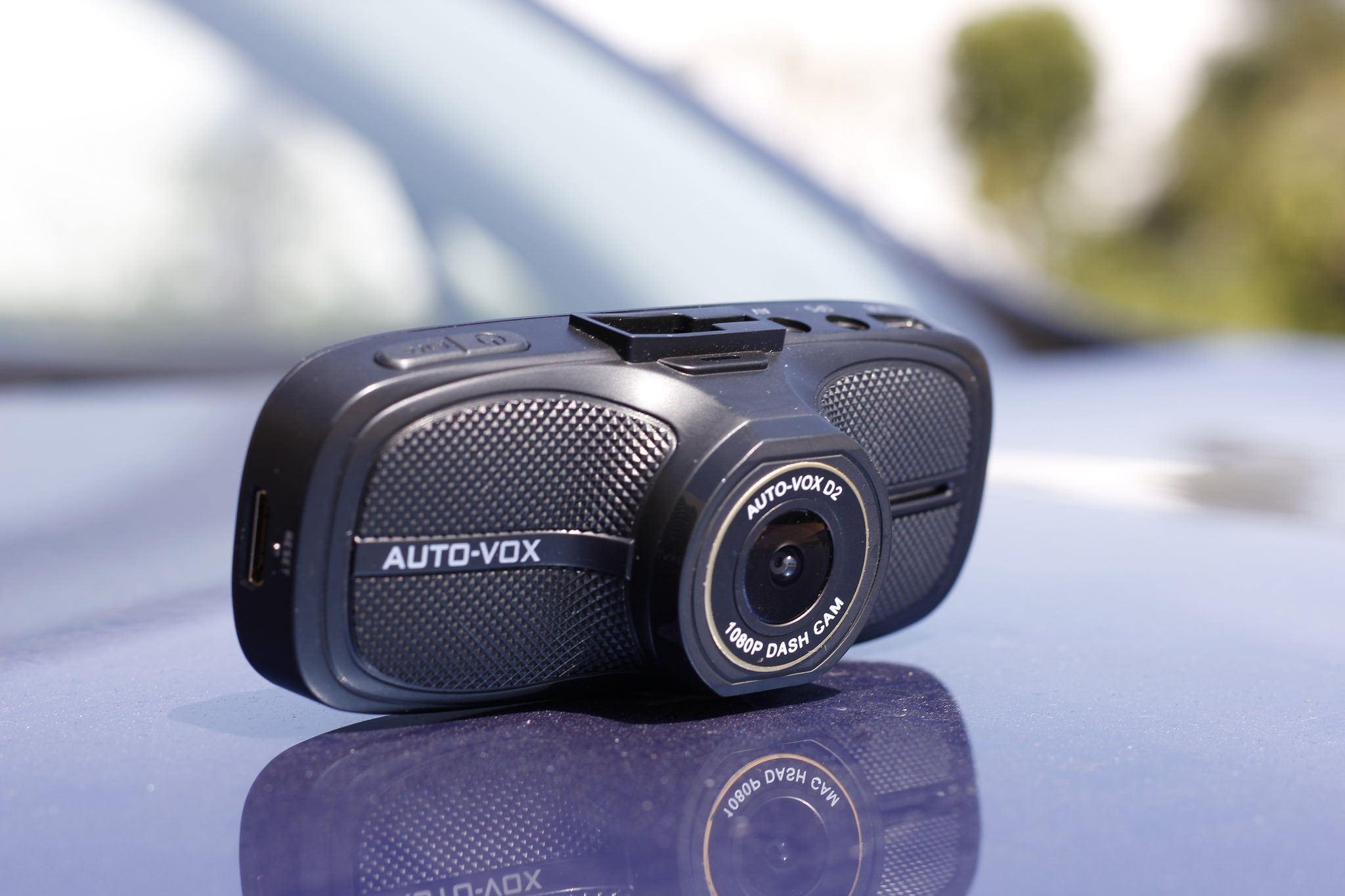
-
-
-
-
- 1080p
- 140° FOV
- 2.7” LCD
- F2.0
- WDR
-
-
-
The D Series from Auto-Vox are very similar in overall layout and style, with the D2 coming on the less expensive side of the scale. The construction is slightly more lightweight, and there is more of a bezel around the screen, while the overall unit is about the same size.
The image quality of the D2 was where the big differences started to show. The D2 picture was blurry, and license plates were very hard to make out. Overall shapes and events can be made out just fine, but for detail this model didn’t live up to the D1. Night recording was also lacking in illumination and overall visibility, which made it hard to get a great idea of what is being captured.
AUTO-VOX A811-C- $56.99
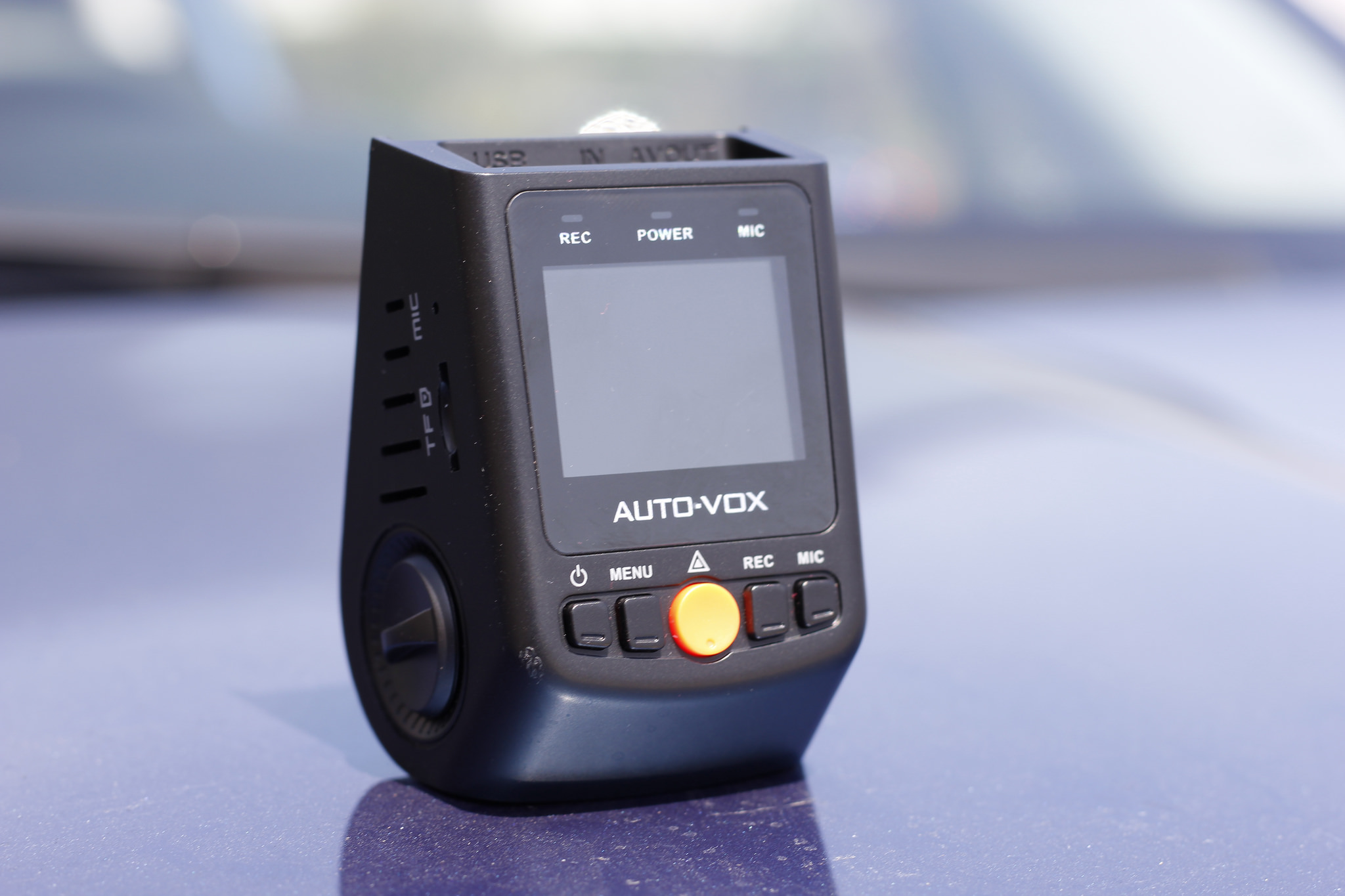
-
-
-
-
- 1728 x 1296p
- 170° FOV
-
-
-
We liked Auto-Vox’s A118–C for it’s wedge form factor that, which means that it could be tucked behind the rear view mirror and out of sight from the interior. The camera lens itself can tilt up or down to the desired angle with a simple turn of the wheel on either side of the device. It’s small wedge form factor also means that the LCD playback screen real estate is one of the smallest of the cameras we tested at 1.5” diagonally. And in case we wanted to lock a video from being overwritten, there’s a prominent orange button that easily keeps videos safe from deletion like an incident.
Despite it’s small stature, the Auto-Vox A118-C delivers great video quality in either daytime or nighttime settings. The camera picks up every detail during the day like reflections on cars, distant street signs, and license plates on either side of the car. During the nighttime recordings, we found that the small camera that could also captures enough light from the area and brightens the video quality without pixelation from under exposure.
SPYTEC A119- $99.95

-
-
-
-
- 1440p
- 2″ LCD
- 160° FOV
- Withstands extreme temperatures (capacitor)
- GPS & speed data
-
-
-
With the wedge style design, Spytec’s A119 packs a lot of features into the compact frame. The five buttons are easy to get to since they sit just below the 2.0” LCD screen. Our issue with the wedge design is that to keep their compact design, they do not come with a suction cup so the camera doesn’t “hang” from the windshield. If you have some type of film or tint on the inside windshield, be prepared that the A119 only comes with a 3M sticky mount, so removal could be an issue. Since the camera mounts slanted with my windshield, it’s difficult to watch playback with the device mounted as the screen is tilted downwards.
In terms of daytime video quality, this camera is one of few that are rated with a 2K resolution of 2560 x 1440 @ 30fps, which makes this one of the best cameras in our lineup. The clarity in the video playback is stellar with details on the road, on cars, and whatever is captured in frame. The nighttime quality is one of the best dash since the dash camera captures light very well. Finer details like street names and license plates are washed out, but the overall clarity in or out of the headlight beams is clear.
SPYTEC VIOFO- $79.95

-
-
-
-
- 130° FOV
- GPS
- F2.0
- 1080p 30fps
- 1.5” screen
- Optional GPS
-
-
-
The wedge style and compact form of the Viofo keeps it small, and the least noticeable when in use out of the bunch we tested. The buttons are quite tiny and it is not the easiest to navigate through the menu because of this, however the record button is the largest. Ideally there wouldn’t be doing too much adjustment once the preferred settings are locked in though so it isn’t too big of a deal if the small form is a key factor. The downside of the wedge design is that most require you to use an adhesive mount to the windshield instead of the suction cup style, which means that you lose the flexibility to move it around and pivot the camera side to side.
The image quality on the Viofo was stellar during the day, and for such a small unit it held its own against some of the larger lens setups. Detail, color, and definition were present in different levels of lighting during the day with clarity. The Viofo did reasonably well at night when there was enough illumination from the headlights and residual lighting, however with the headlights along it was hard to see some of what was going on at the edges of the coverage. The strength of the coverage in center-beam tapers off quickly, and unfortunately the license plates were also washed out in the headlight beam.
Rexing V1- $99.99
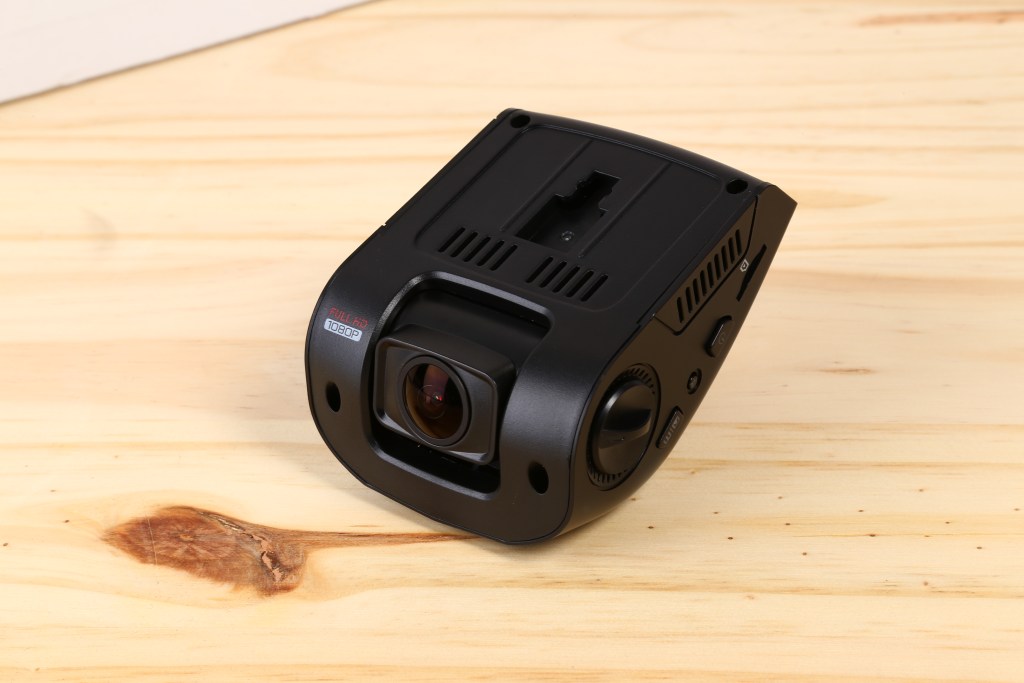
-
-
-
-
- 1080p
- 170° FOV
- WDR
- 2.4” LCD
-
-
-
We do like how discrete this model is, and the wider FOV allows for more visibility in the front fender areas. The picture quality was also very good in daylight. The picture quality in the dusk/night settings was not quite as bright as we would have liked, but was still good, The navigation through the interface was a bit cumbersome at first, but became easier a few times through and overall was not bad.
Sansco M60- $54.99
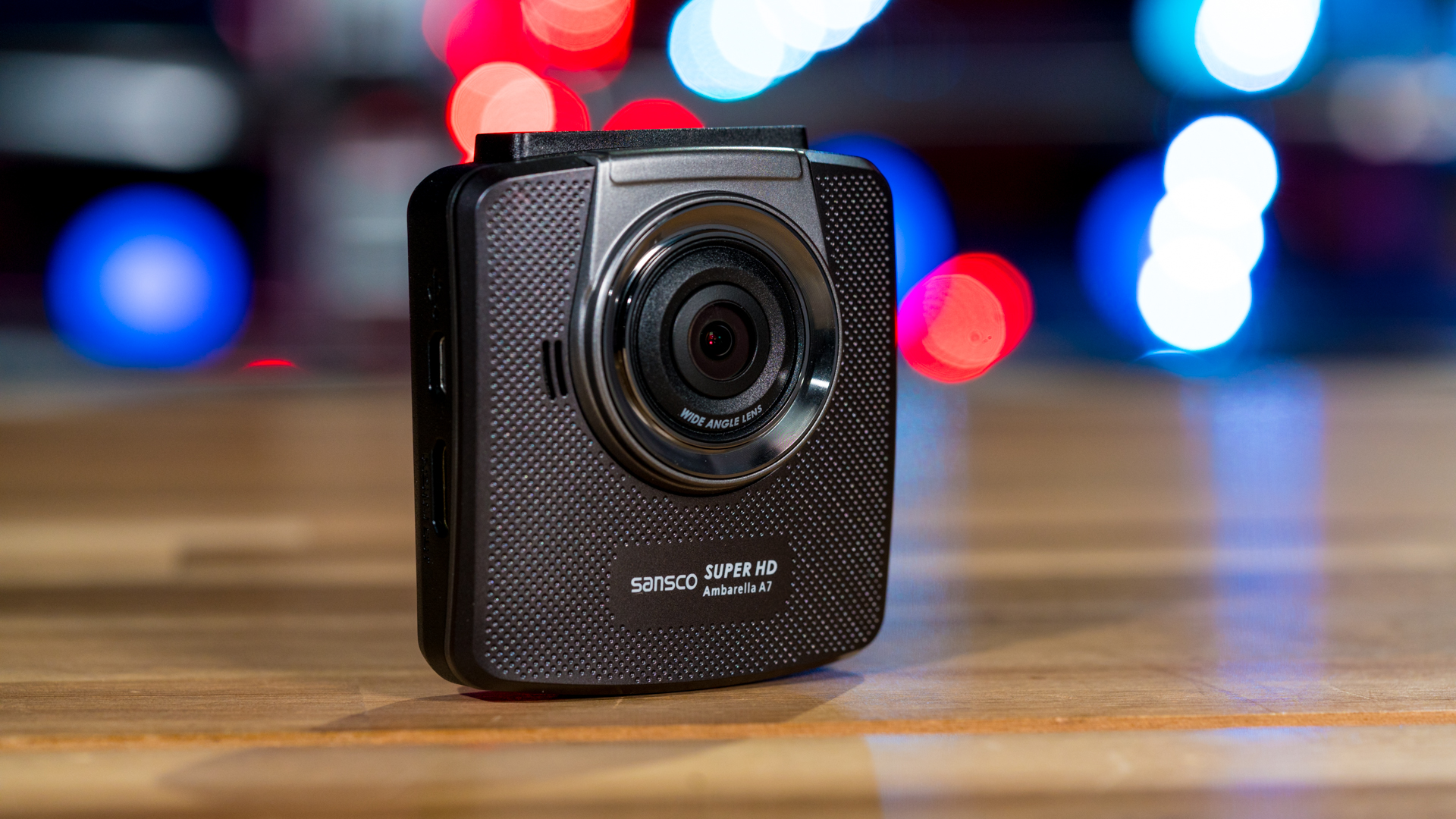
-
-
-
-
- 2.4″ LCD
- 150° FOV
- 24 Month Warranty
-
-
-
The Sansco M60 looks slick with the black and grey plastic accents but the device feels light for a medium sized camera with a 2.4” LCD screen. With its square and thin shape, the M60 is the smallest camera of its M20 and M30 brethren which we found easy to tuck behind the rear view mirror. Image quality on the screen are good, but what should be straight lines turn into jagged pixels during playback on the device.
The M60 boasts 1296p resolution, or a near 2K recording experience. Coupled with a 150° FOV, daytime and nighttime videos were amazingly clear and well lit. Daytime videos capture vibrant colors and fine details whether we were looking at license plates or street signs during playback. At night, the M60’s High Dynamic Range picks up the surrounding light and illuminates the road whether objects were in the headlight beams or not.
Sansco M30- $54.99
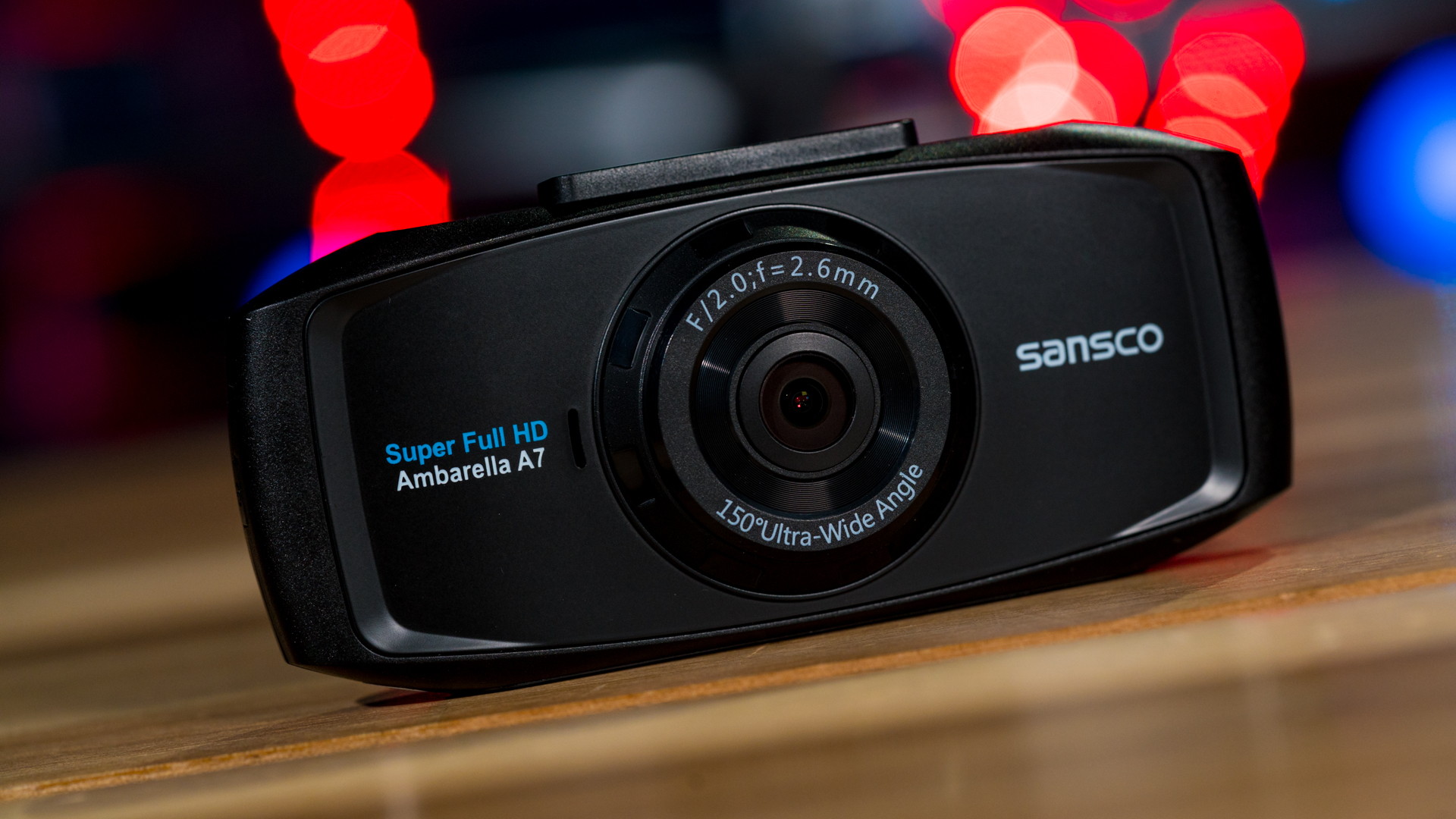
-
-
-
-
- A7 Ambarella chip
- 2304x1296p
- 2.7”LCD
- 150° FOV
- WDR
- F2.0, f=2.6mm
-
-
-
Like the other Sansco models, the M30 has a lightweight plastic construction, and is a bit hollow-feeling. The buttons are large, and navigation through the menu is pretty straightforward. This model is more discrete than the M20, with a more slender design. The screen is plenty large enough to see anything in the menu and video playback, however the image quality is not as clear.
That isn’t to say the image quality is bad, and surprisingly enough for something that is so lightweight it actually has a solid image. Driving into the sun was a little challenging to clearly capture license plates, however the WDR did a good job of picking up the details very clearly when the sun was not directly in front of the lens. The night performance was also admirable, and picked up the details with ease across the substantial 150° field of view sharply.
Sansco M20- $74.99
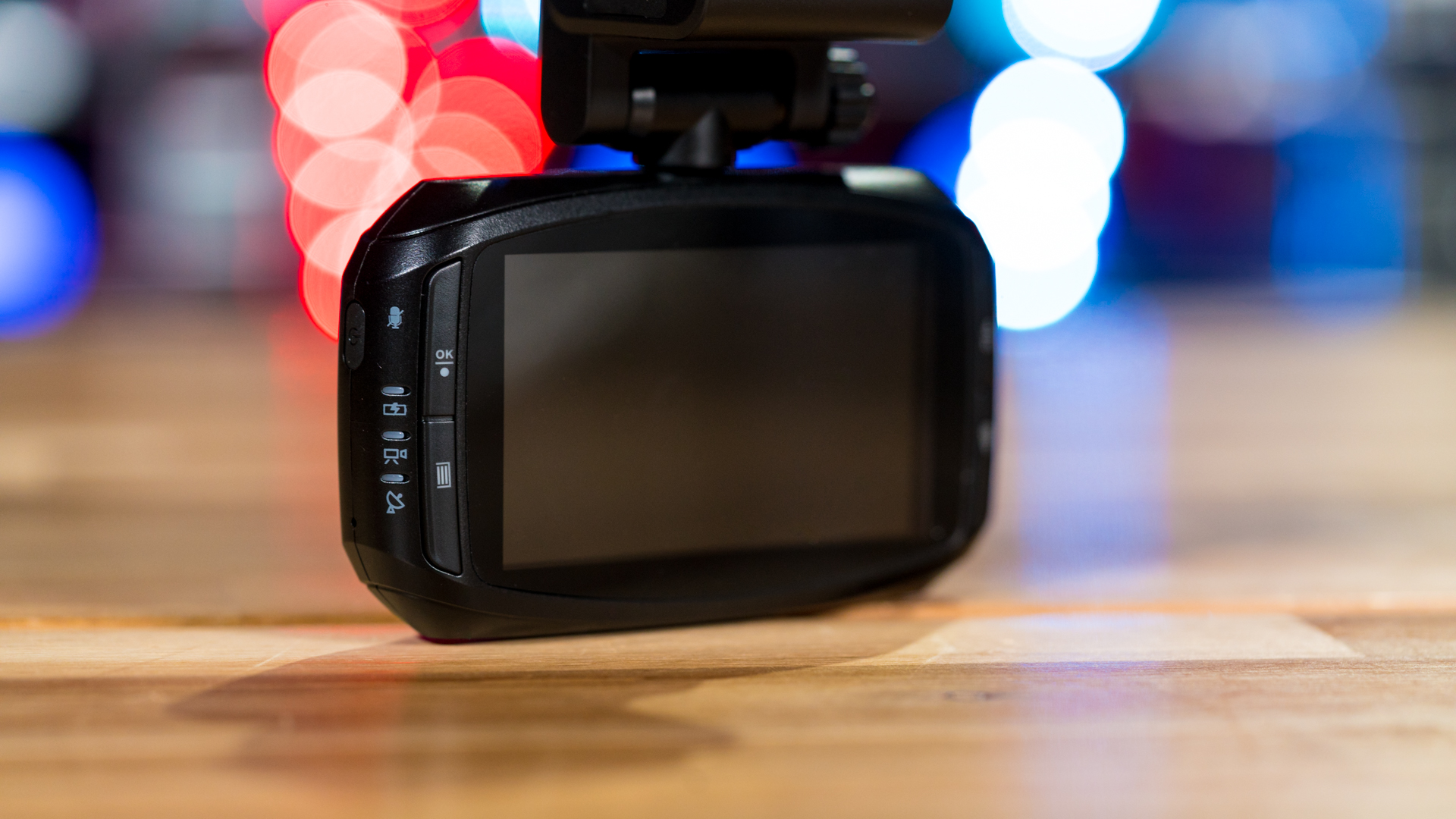
-
-
-
-
- Ambarella A7 chip
- 2304x1296p
- 170° FOV
- WDR
- 3” screen
- F2.0, f=2.6mm w/IR filter
- GPS
-
-
-
The M20 has a big body, wide and tall for a dash camera but without too much depth. The screen is quite large as well, very bright and clear. 3” is a bit larger than needed for most, but the playback visibility is great. The button layout does make them a little difficult to operate, since they are slim and placed on a bevel. It is quite lightweight, however the cable connection has an interesting design that received a little extra thought. Instead of connecting directly to the camera the power runs to the suction mount, which has a higher point of contact so there is less visible cord when it is tucked up. The M20 has a GPS function that can be added by a USB plug to the suction mount which seems to work well, however it is a bit large and could have been integrated into the camera unit itself since the construction isn’t very dense.
The M20 video quality was very good, and gave a wide FOV which maintained clarity out to the edges in both day and night settings. The picture was smooth without any pixelation or trouble adjusting from darker to brighter scenes, and while the illumination at night caused the license plates to wash out it was a solid performer in the test.
TaoTronics CD05- $59.99
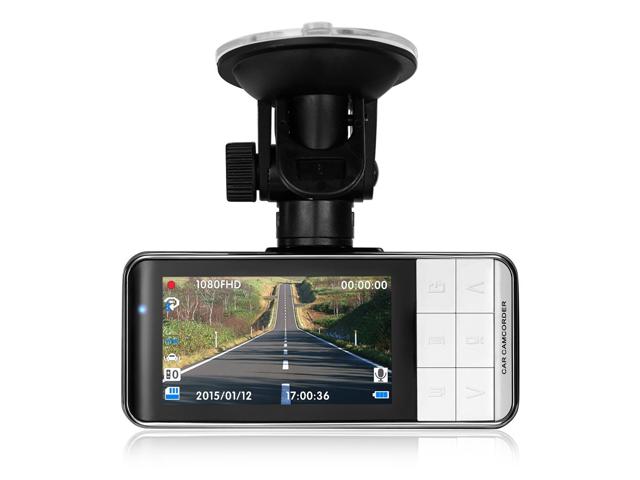
-
-
-
-
- F2.2, f=2.78
- 1080p
- 150° FOV
- 2.7” screen
- White balance settings, sharpness adjustments
-
-
-
The TT-CD05 looks the most stylish out of the bunch, reminiscent of a Sony Ericson phone. All the rather large buttons are consolidated in a grid on the rear of the unit, and while a bit larger than necessary it makes them very easy to hit. This is another one of the few out of the bunch to have digital zoom, which is interesting and while not useful in all circumstances, could prove beneficial if trying to catch a license plate fleeing the scene of an accident. It’s a pretty wide unit, and a touch thick, but there is not a lot of wasted space as the screen extends quite close to the edge. The screen is very clear and navigation is simple, and the interface is straightforward. Construction feels solid, the lens is nice and large, and spite my preference for smaller dash cams I find myself very fond if this one.
The TT-CD05 video quality was fantastic during the day, and the 150° FOV was filled with sharp detail. With multiple white balance and sharpness settings, it would be easy enough to tweak the image more to help out the night recording. While the day footage was crisp and clean, the night suffered a bit from both washed out license plates and tunnel vision around the headlights. The digital zoom worked very smoothly though, and this was an interesting addition to the camera that produced smooth pull in/out when recording.
TaoTronics CD06- $79.99
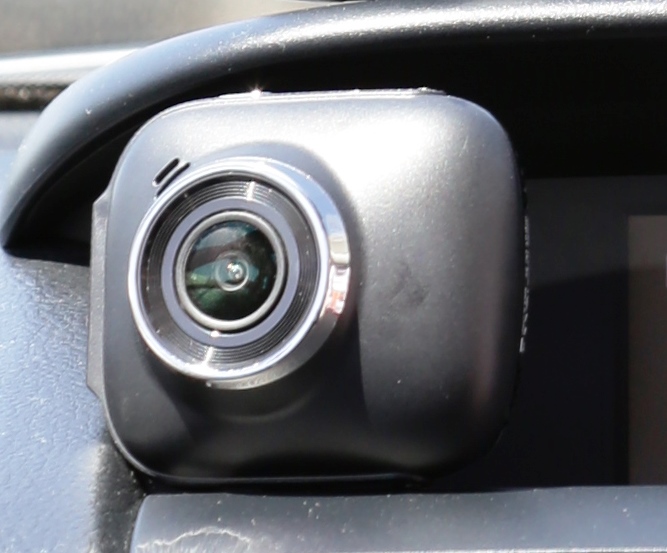
-
-
-
-
- 160° FOV
- 2” LCD screen
- 2K
-
-
-
The CD06 design looked the most like a toy out of the test group, with a rounded bubble of a front cover. The lens is large though, and overall it is very similar in proportion and design style to the Wheel Witness. Buttons are easily accessible while navigation is straightforward and simple, but the video quality is what makes this a serious dash camera. The day recording had great detail, with a sharpness that was impressive for the size and construction of the unit. Night recording was equally as impressive, and the wide FOV captured a substantial amount of the front end and lanes to either side of my vehicle. The detail in the low-light situations was illuminated without being grainy, and the clarity was spot-on.
SoundLogic XT- $27.75

-
-
-
-
- Acts as both rear-view mirror and records vehicle front view
- 1080p
- 2.4″ LCD
- 120° FOV
-
-
-
One of two rear view mirror dash cams that we got to test is the SoundLogic XT. The design of this camera may not fit with your existing rear view mirror if it’s too big or if you have programmable keys, which could be hard to press with the XT installed. The camera has four bendable rubber arms that wrap around the back of the existing rear view and are held together by two rubber clips. The camera barely fit on my rear view mirror and I had to shift the XT camera to the left until my programmable keys could be pressed. We feel that the XT is better suited for older cars without programmable keys on their rear view mirror as this isn’t an upgrade for cars with them.
The 2.4” screen and camera are the left side of the mirror, but we found that since rear view mirrors are always tilted towards the driver, the camera on the back of the mirror can’t turn left enough so our FOV was the worst of the dash cams tested.
In terms of video quality, this dash cam advertises 1080p quality, but it honestly seemed more like 480p. Since the camera can’t turn enough, the FOV was limited so we could see what’s on the left of the car but nothing on the right side, which isn’t ideal for capturing traffic incidents. The daytime video quality was poor, with jagged-pixelated lines running rampant across the video. License plates can be seen within 15 feet directly in front, but anything past that was unreadable. Nighttime recording was the worst in our tests, as the camera could only record what was directly in the headlight beams and any other light sources, but anything in between those lights is very dark.
SoundLogic XT Slimline- $23.99
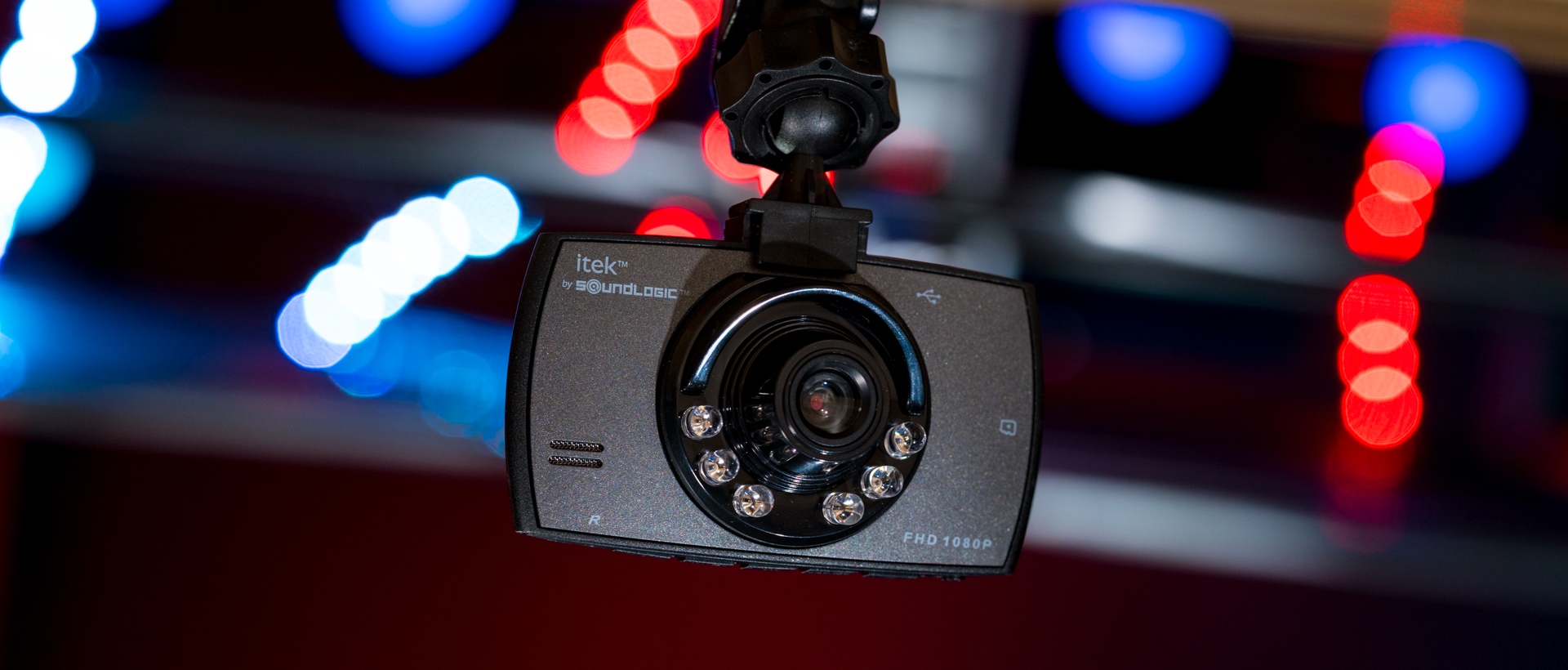
-
-
-
-
- 2.4″ LCD screen
- 120° FOV
- 1080p HD resolution
- Built-in IR-lights for night mode
-
-
-
SoundLogic’s XT Slimline dash camera is compact for those like us that like cameras that can be hidden, but the build quality feels of light-plastic. It has a 2.4” LCD screen with six buttons on the bottom edge to navigate, but unless we tilted the camera out of position, we found it difficult to navigate while keeping the same recording angle.
As for the video quality, the XT Slimline boasts 1080p recording, but the quality was below average. Daytime video was very pixelated, and unless you’re looking at highway signs, it was difficult to read license plates past 10 feet in front of the car. Nighttime playback experienced similar issues as the day, and despite the built-in IR lights for night mode, the quality was very grainy and light sources were over exposed leading to washed out objects. For a cheap dash cam option, you can slap this on your windshield sub-$50.
TimeTec CM-M211- $99.99
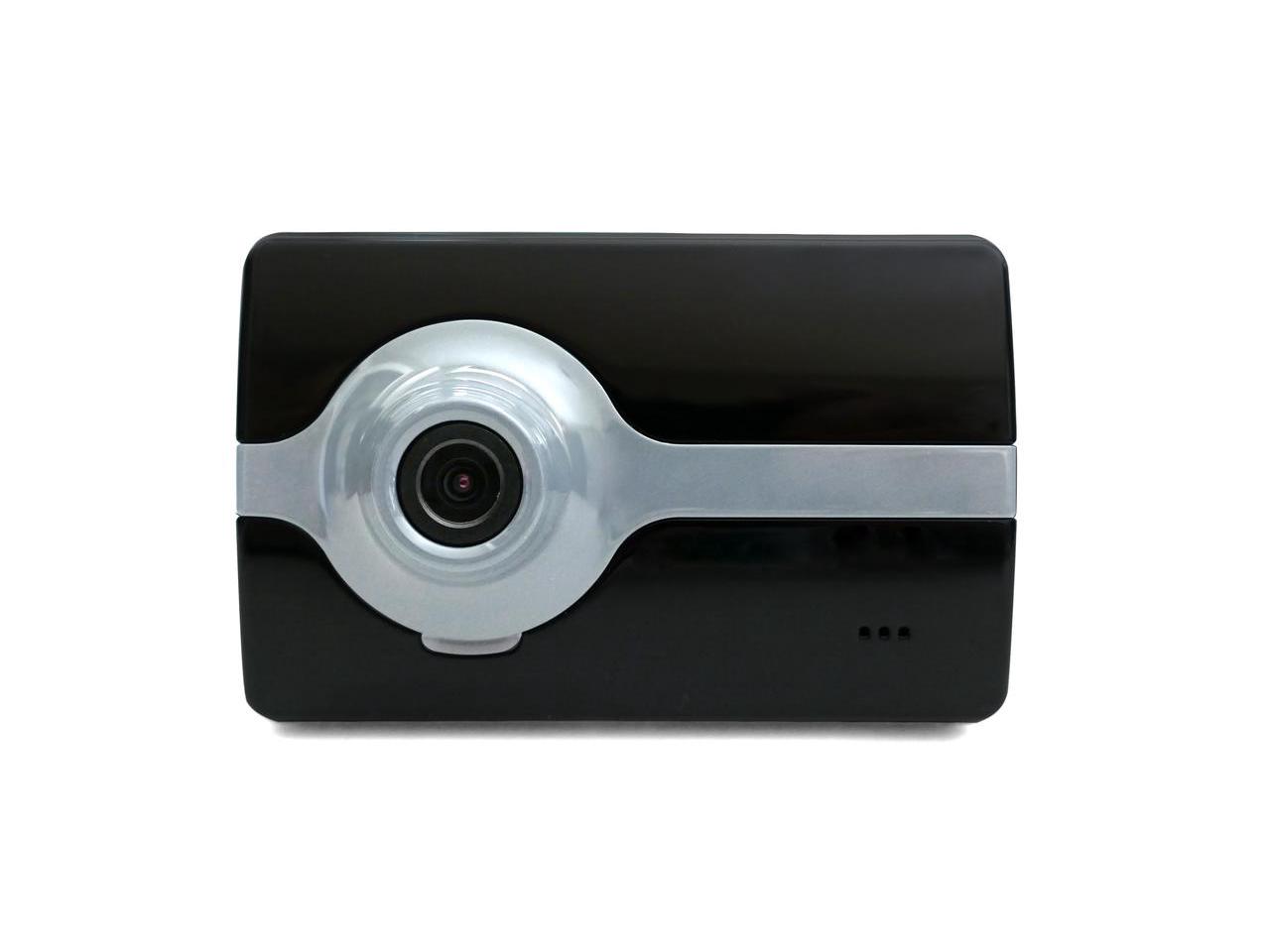
-
-
-
-
- 1080p resolution + ADAS (Advanced Driver Assistance Systems)
- GPS receiver, 3-Axis acceleration sensor
- 16GB card included (support up to 64GB)
- PC software
- 3.5” touch screen
-
-
-
In all our testing, TimeTec’s CM-M211 is the only touch screen dash cam in the round up. With a 3.5” LCD screen, this is the largest camera of the litter. The only button switch on the camera is the power on/off and all other navigation defers to the touch screen controls. The on-screen controls are large and easy to read, but we prefer tactile feedback from buttons to confirm a key press. Despite its large size, the CM-M211 has a lightweight plastic construction feel on the outside that houses the more important components like GPS and an advanced driver assistance system with lane departure found in newer cars.
The day and night video quality was surprisingly clear despite the hollow construction feel of the camera, and the FOV in both settings easily captured lanes on either side of the car. Videos in the day were clear and we can easily see fine details like license plates 15-20 feet away from the camera. Nighttime video captured the road and the surroundings well, even the low light conditions, but we felt the color was flat with a tinge of gray. This is a very minor issue considering that the video quality in either lighting condition is superb.
TimeTec Roadhawk DC-2- $89.99
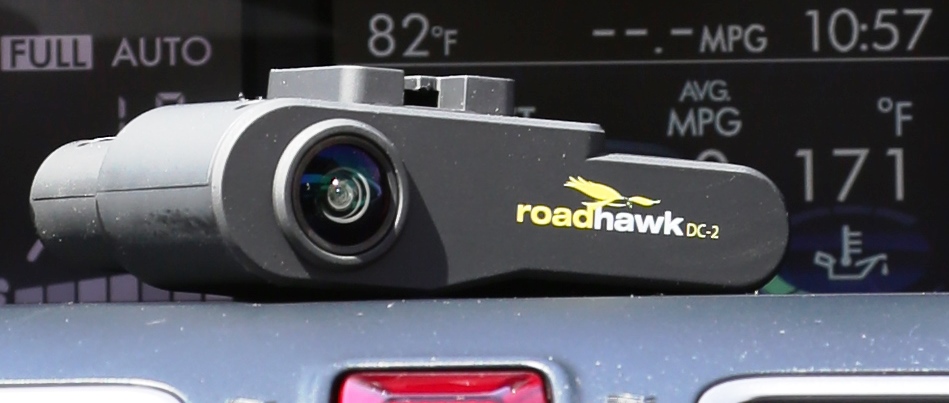
-
-
-
-
- 1080p
- 127° FOV
- Software for video editing, with data gathering and implementation in on screen visuals
- Gyro stabilization
- 1HZ GPS
- A5S Processor
- SD card
-
-
-
The Roadhawk falls along the lines of the BlackVue we have previously reviewed, in the sense that it isn’t for the average driver just looking for some safety on the road. Granted that’s what it can be used for, however this is designed for racing, which comes with a software for extracting all the data the camera can collect. G-forces, video editing, mph, custom loop length, mic sensitivity, and other aspects as well as tachometer, lap time, track map which is drawn as the car travels around the course, etc. All aspects are set in the Race Render software, which then plugs in the parameters to the video that you capture on the track while you are driving. The video editor gives you access to customizing the screen info that appears on the finished video.
The physical design is lacking a screen, which isn’t necessarily a bad thing if there was another way to select the different modes for recording from the device. The lack of this makes it harder for the daily driver to use as a safety precaution in a seamless way. There is a button for emergency recording, which locks the clip to memory but all other functions must be done in the software. The design is a bit large overall for not having a screen, however it could still cozy up behind the rearview mirror without anyone really noticing.
The video quality is good during the day, and small details can be seen pretty easily. Surprisingly, even though the FOV is stated at only 127°, there seems to be a greater area captured on film than some of the other cameras claiming 140° plus. The night visibility for objects is good as well, and the picture out to the edges of the screen are still well-illuminated enough to capture details. The license plates do get washed out in the headlight glare, so it could use some adjustment there to find the right balance. The ability to edit videos and overlay graphics from data picked up during driving is really unique though, and makes this more of a fit for the the adventurous driver over the daily commuter just looking for protection.
Vantrue N2- $124.99
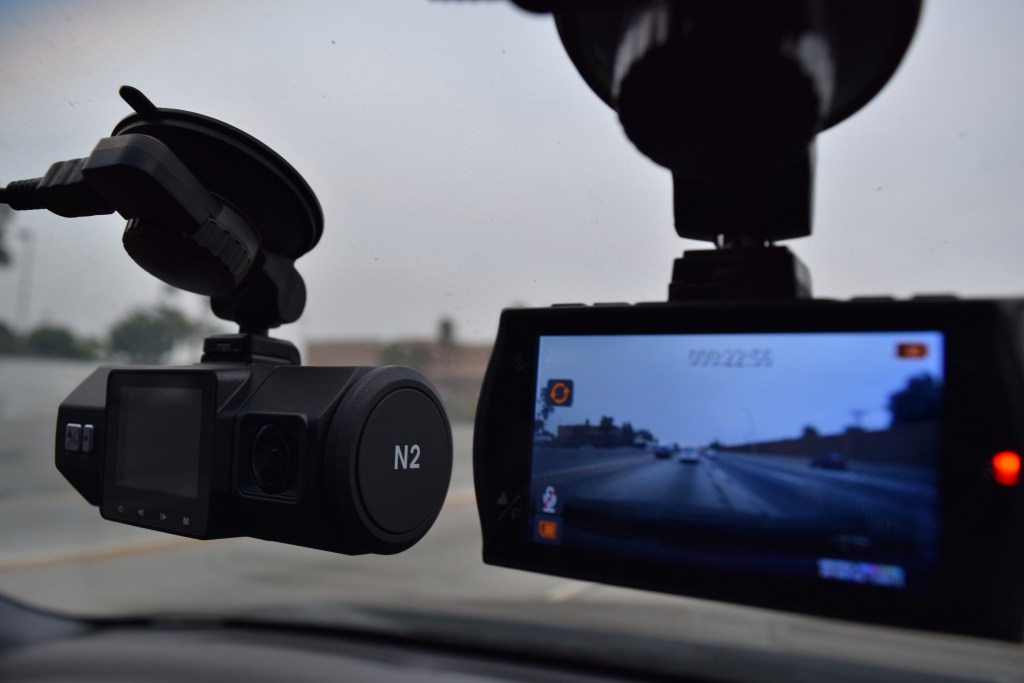
-
-
-
-
- 1080p
- 170° FOV
- Ambarella A12 CPU
- 1.5” LCD screen
-
-
-
The Vantrue N2 has a very unique connection, where the Mini USB plugs into the mount, and the mount itself carries the power through to the unit. This is different than anything the other models have, and it means the power cable connects to the absolute highest point on the unit, making it easy to have clean cable management set up. The camera is also removable from the mount, so if for whatever reason it was needed to be removed from the vehicle the whole setup is not thrown off.
Vantrue X2- $119.99
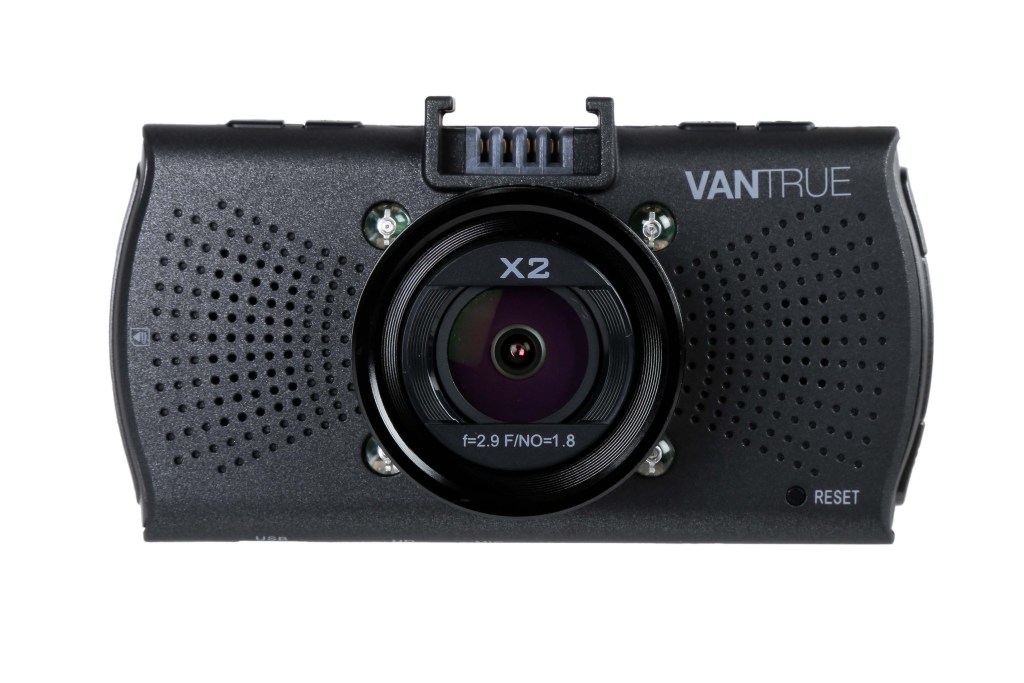
-
-
-
-
- 2560x1440p
- Ambarella A12 CPU
- 2.7” LCD screen
- 170° FOV
-
-
-
This model is a lot sleeker than the N2, and showier too. The majority of the physical depth of the camera is the lens, which makes sense since the whole purpose is to have a quality picture. The screen is large, and very clear. All the function buttons are located around the frame of the unit, further adding to the clean look of the camera.Like the N2, this model also has a unique power connector. The heft is also similar in this model, and it feels dense.
The features that this model has are all very similar to the N2, however the quality of video on this is much better. Also, in a side-by-side comparison you can clearly see that the X2 takes the cake for actual FOV, putting that big lens to work.
ELECWAVE D200-$39.99
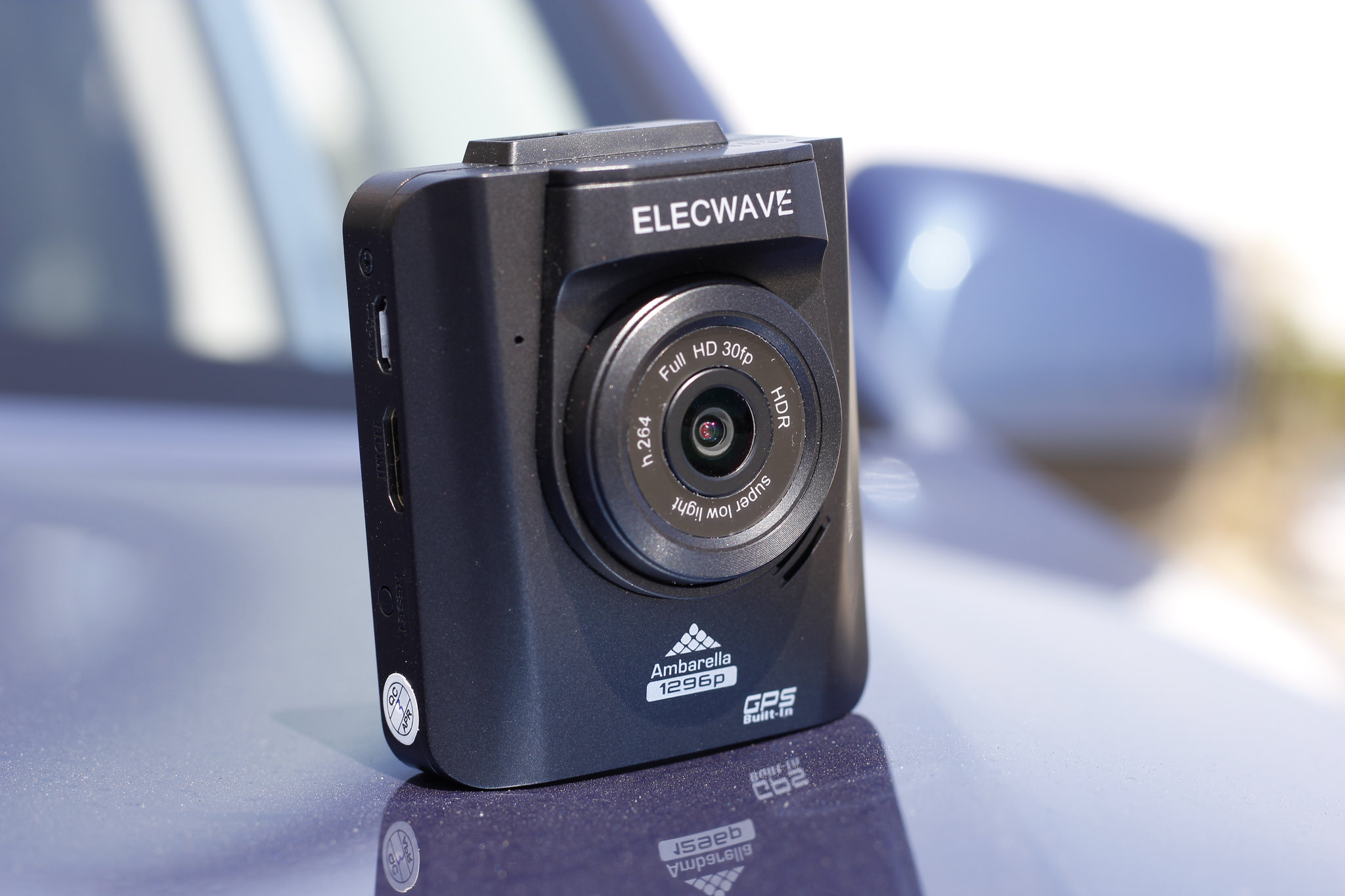
-
-
-
-
- 170° FOV
- 2.7” lCD
- GPS
- 2K (measured at 2560×1080)
- Ambarella A7L50 Chip
- White balance
- 13 EV settings
- WDR
-
-
-
Out of the square “hanging” cams we have, this is the largest and the least discrete. The construction however, is very solid, and the lens quality is legit. The space seems like it could have been more efficiently used, as the buttons are spaced out quite a bit, and there is still space for the screen to expand (or the form to shrink). As with the other Elecwave models that we had though, navigation through the menu is simple and straightforward.
The picture from the D200 was decent, with good detail in both shade and bright light. We would have expected a little more clarity however, as license plates were not as easy to make out from other lanes. The amount of exposure settings is impressive though, and with the white balance adjustments offer a variety of settings to tune the picture. This should come in handy when dealing with the night filming, as the stock picture was pretty dimly-lit.
ELECWAVE D300- $49.99
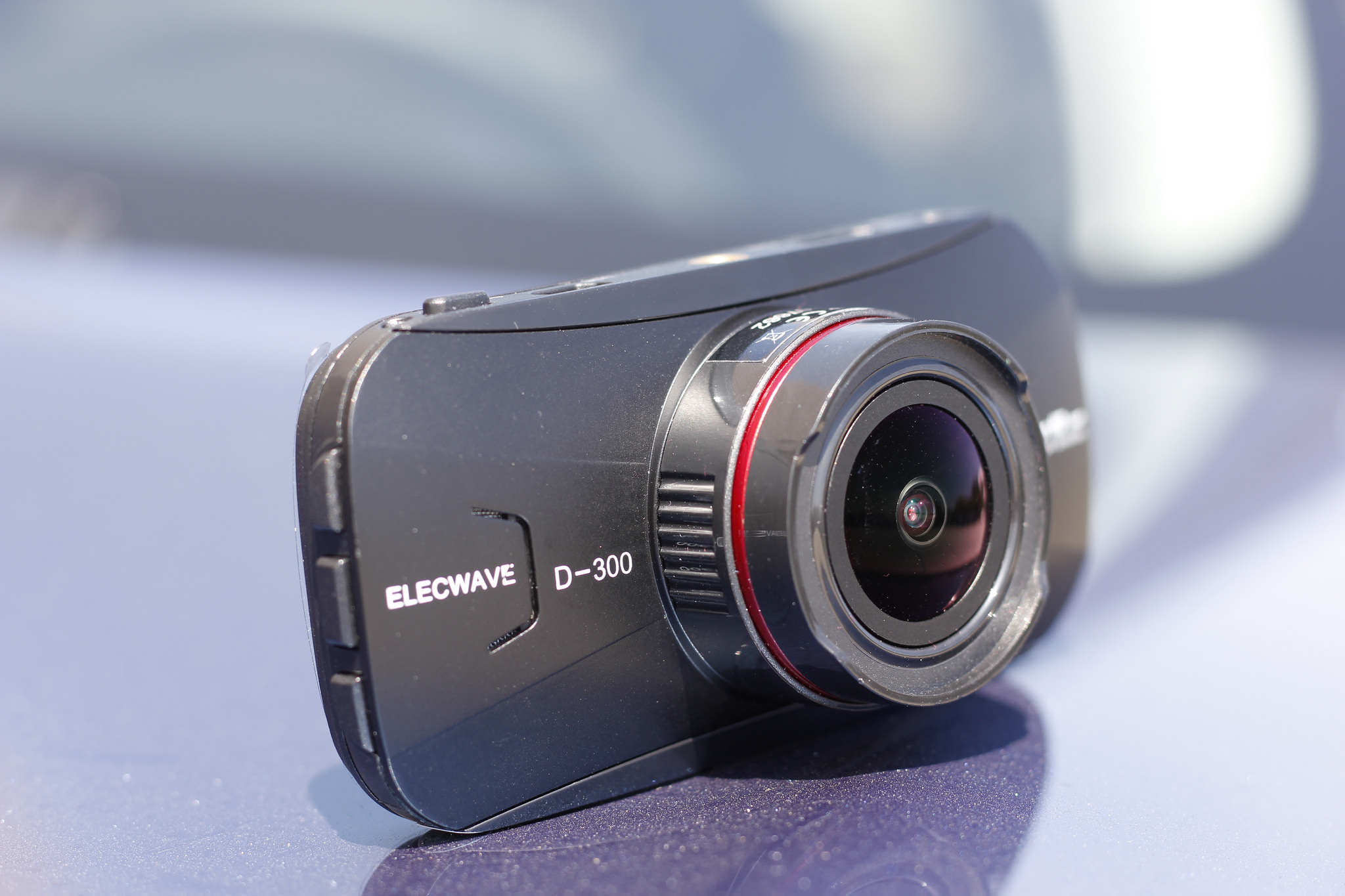
- 170° FOV
- GPS
- Ambarella A12A5
- 3” screen
- WDR
- 1440p resolution
Construction quality of this one is solid. The weight is good, and the materials feel very well put together. The screen is not overly large, although it is large the buttons are moved to the sides which keeps the back from getting too large trying to accommodate buttons. The lens is pretty large, and the menu navigation is simple. From the physical design perspective alone, this is my favorite out of the bunch.
The video of the D300 doesn’t disappoint either, and daytime in different lighting conditions it performed exceptionally well. The clarity was outstanding and the detail to the edges of the 170° FOV was sound. During night recording, the picture had a warm hue to it that did provide illumination for the road in general, but that mixed with the low light setting caused the business signs to become illegible often. Despite that, the overall performance of the D300 at night was great, and made for a solid all-around camera.
ELECWAVE- D100 $19.99
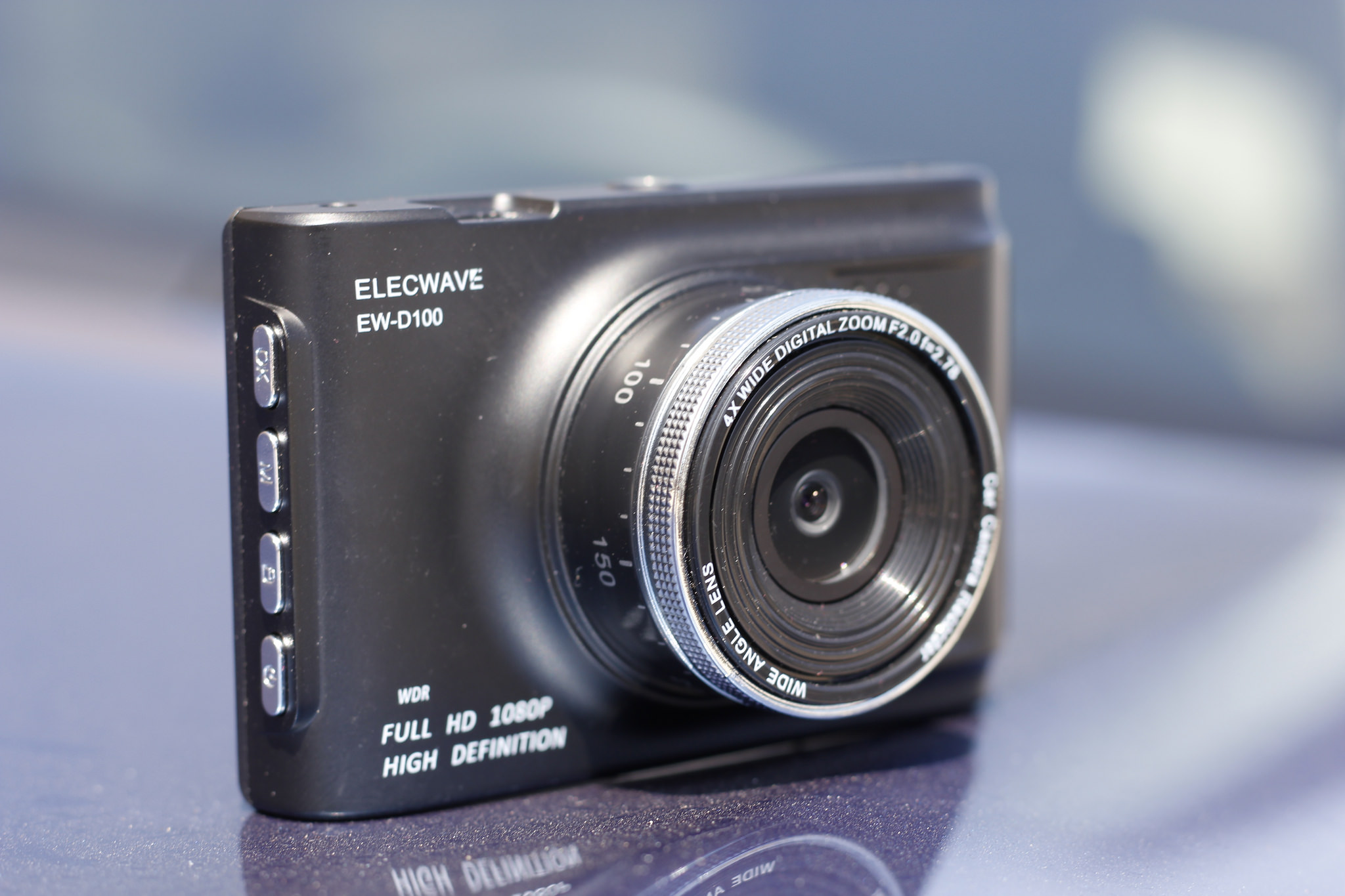
- 1080p
- 140° FOV
- 4x zoom
The Elecwave D100 has a very solid feel and weight to compact, dangling dash camera. It sports a 140° FOV, 4x wide lens zoom, and large 3” LCD screen that takes up the entire size of the camera. There’s seven buttons to navigate the interface, in addition to zoom buttons that help capture objects like street signs or license plates that might be needed for any incidents.
Both the day and night time recordings are OK at best. Despite the weighty feel of the dash camera, video quality is pixelated, and in the night time footage, there’s some motion blur. The FOV also feels like we are zoomed in ahead of the car hood without the details, which we personally did not like.
Papago! GoSafe 350 mini- $129.99
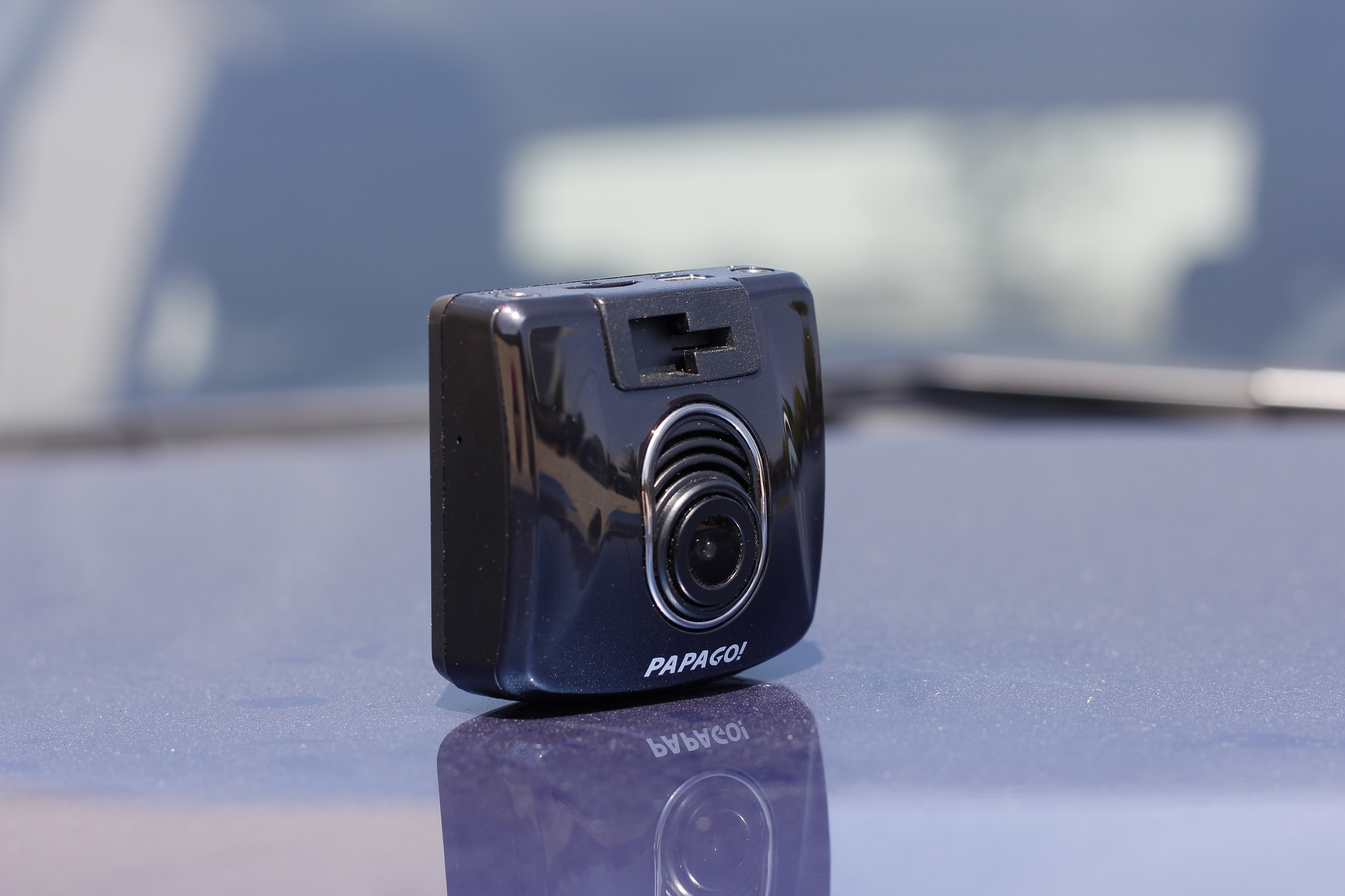
- 1080p
- 2” screen
- GPS
- 142° FOV
The daylight recording was good for the GS 350 Mini, even when facing direct sunlight which was an area other cameras had trouble with. The FOV could be improved upon though, as it seemed even for 142° there left a little to be desired. Night recording was decent as well, and the illumination was on point. License plates and street signs were not as washed out in the light as we would have expected, and the detail was good without being grainy.
The GS 350 Mini from Papago! has an interesting design for the suction clip, it has the GPS module built in and a 3.5mm jack which connects it to the unit. We suppose that is in the event that you don’t want to have GPS enabled you could not plug in the cord, but it seems like they could have just made the connection on the inside of the mount and have a cleaner layout. The form factor is small and compact, with a reasonable-sized screen to size ratio. The weight is a little on the lighter side, but overall this is a nice unit that looks inconspicuous on the windshield. The button placement is clean and navigation throughout the menu is simple and quick. They interestingly added the mount point to the front of the unit, and opted to put the power/AUX connections and MicroSD card slot on the top. Space-savings is the theme of this camera, and we are quite fond of it.
Papago! GoSafe 30G- $159.99
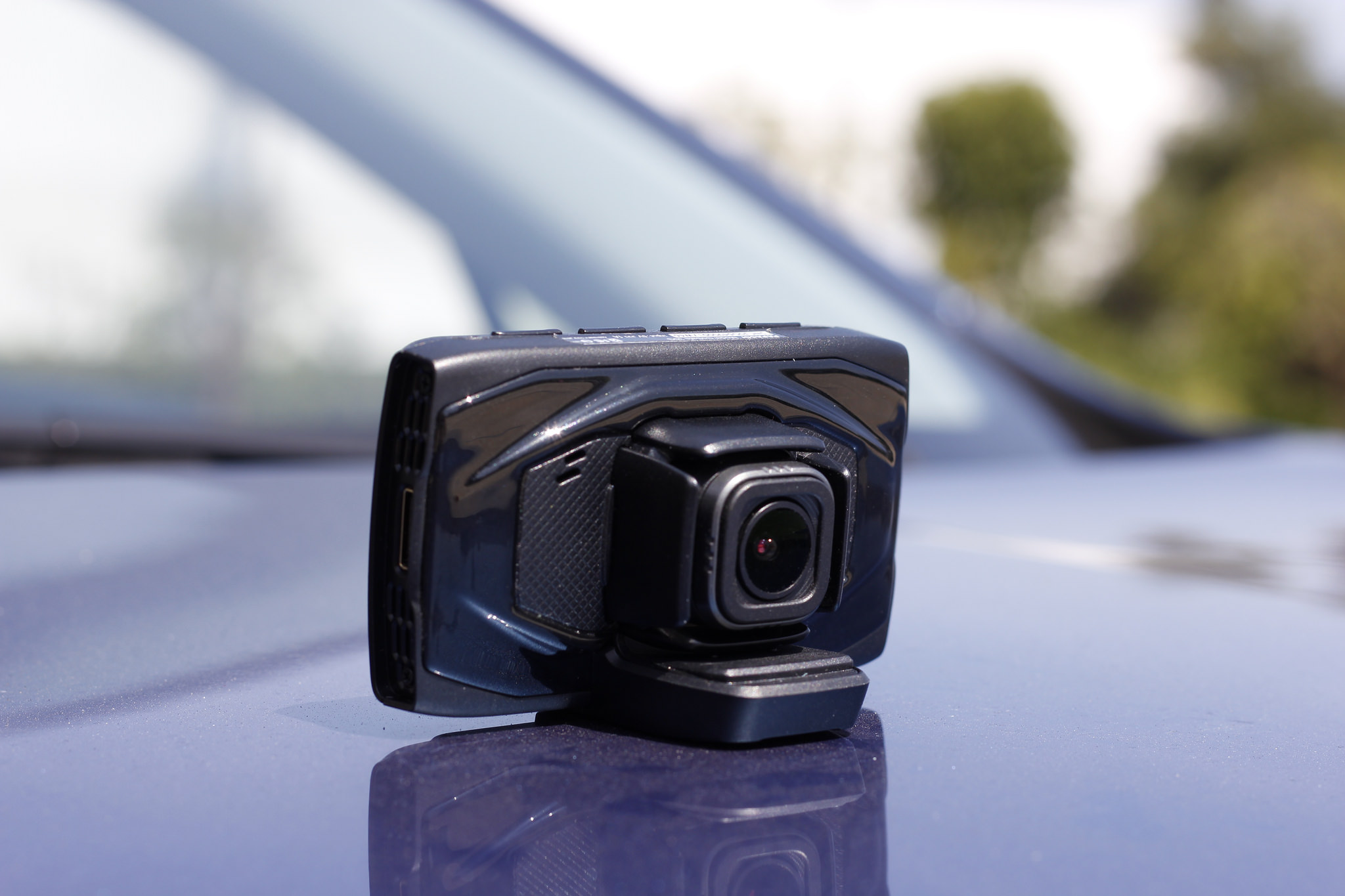
- 1080p 60fps
- 2.7” screen
- GPS
- 140° FOV
- 13 levels of exposure adjustment
The GS 30G has a bit of a peculiar design, with a plastic overhead above the lens, which we expect is designed to keep the overhead sun from creating a glare, and it seems to work quite well. The construction is solid, however they could have made the overall size much smaller, since the screen bezel is pretty large. We think they should have reduced the size to make it more compact.
Both daylight and night recording were similar to the GS 350 Mini, and FOV is also just about the same. The 13 EV settings is an interesting feature, and the 60fps did deliver a smooth video that captured the actual movement well.
Papago! GoSafe 770- $119.99
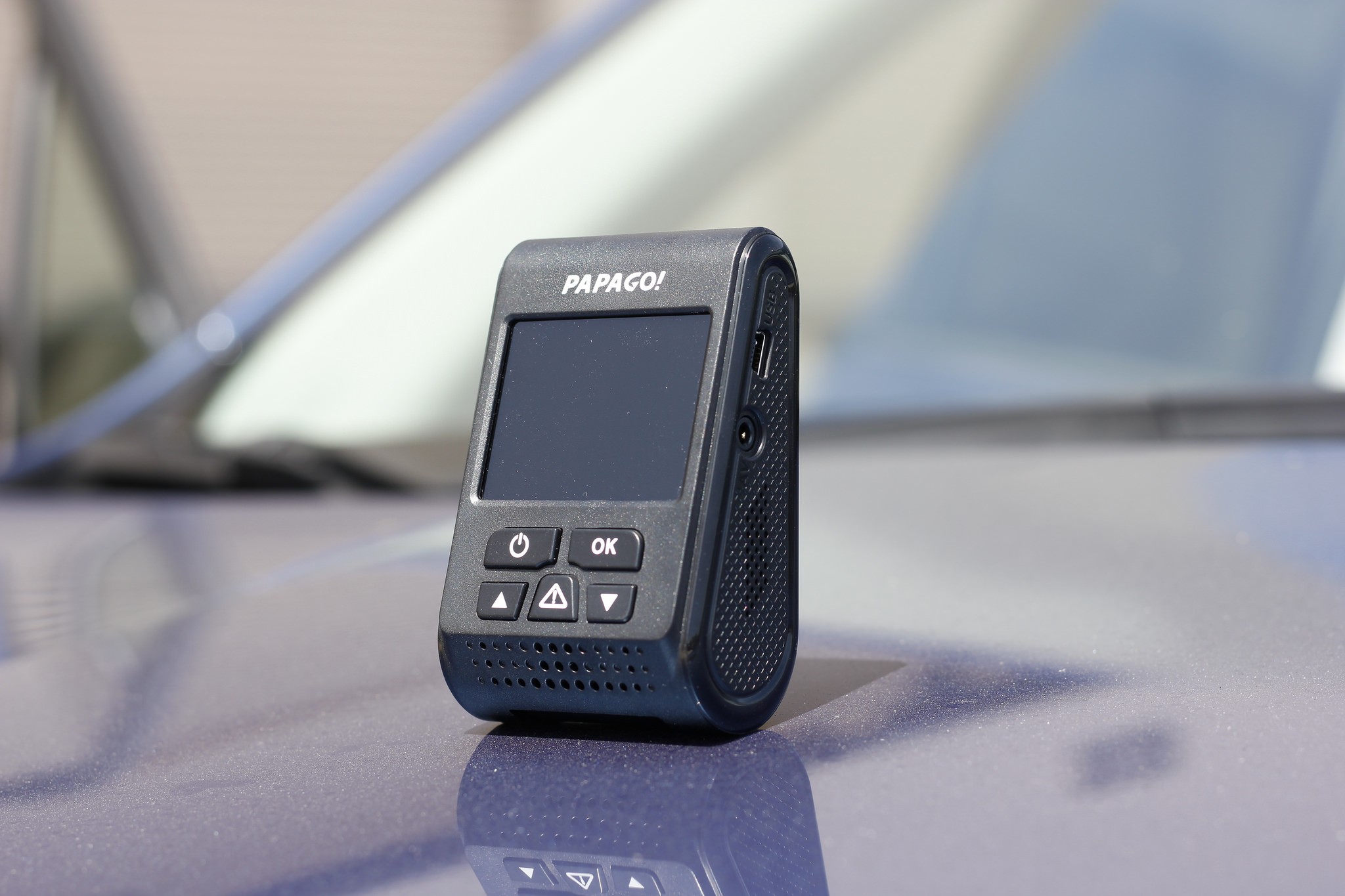
- 1440p
- Built-in GPS logging
- 160° FOV
- Driver assist features
Here’s another wedge designed dash camera, but this time, Papago’s GoSafe 770 houses 2K resolution capabilities in compact form factor. It looks oddly familiar to another dash camera on this list, the Spytec A119, with a similar wedge design, resolution, and five button layout. It’s easy to operate, but the screen is hard to see without removing the camera from the mount and watching the video playback that way.
Both daytime and nighttime driving videos were superb, especially in the daytime where there’s plenty of clarity in leaves to signs. At 2K resolution, the daytime video doesn’t disappoint since we could read signs and license plates on either side my car. Nighttime stumbles a bit like many other dash cameras and street signs and plates get washed out with too much reflecting light. However, the camera does a great job capturing in any light source and brightening the playback.
Papago GoSafe! 760- $219.99
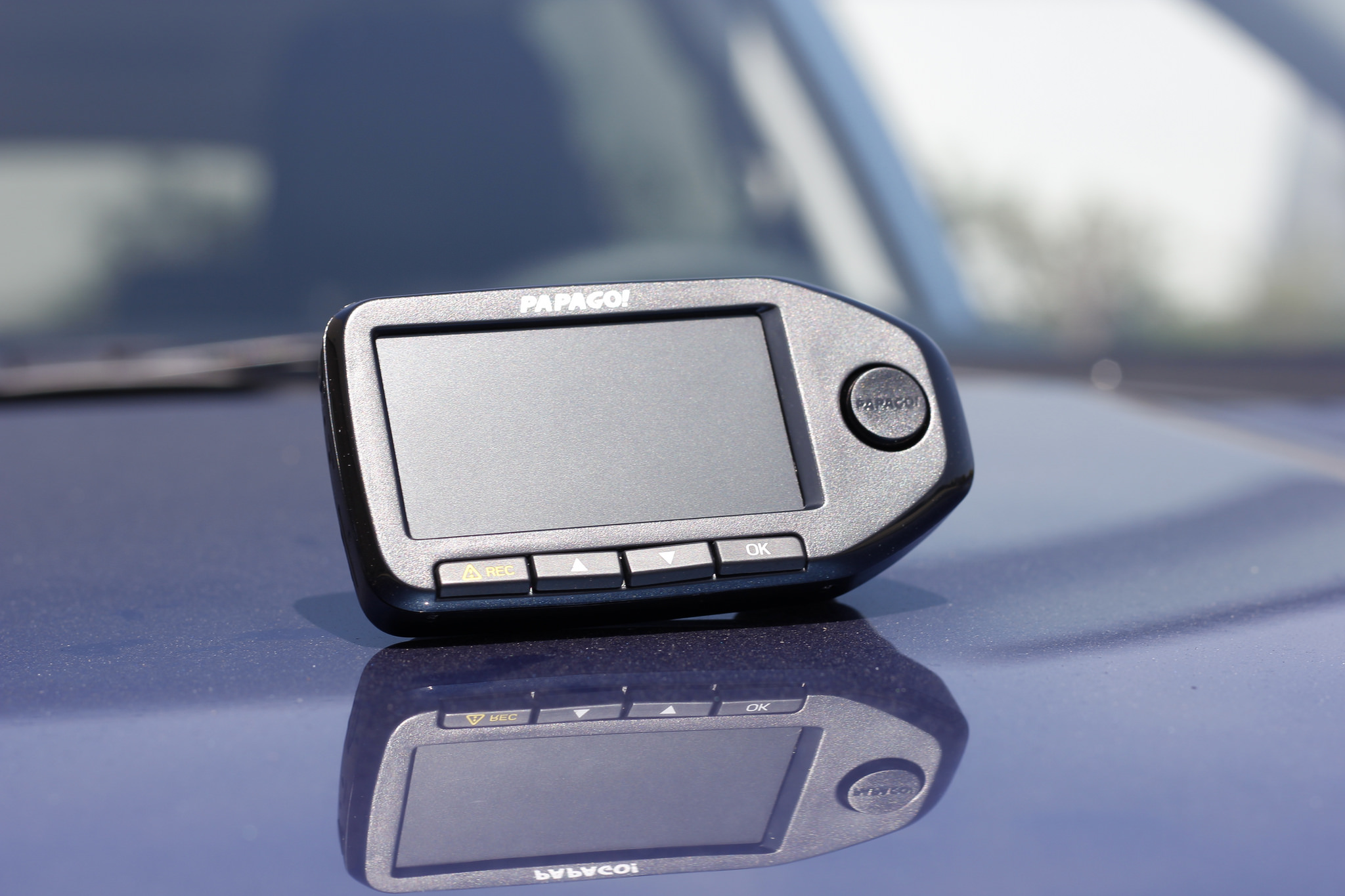
- Front 140° & Rear 120° FOV
- Super Night Vision
- Two different mounts
Unlike the other dash cams that see only what’s in front the car, Papago’s GoSafe 760 comes with a separate camera that can be used to monitor what’s behind the car. We did not test the rear camera since the other cameras in this round-up are only front-facing cameras, so there wouldn’t be an equal comparison.
This camera is sleek and slim with only five buttons to help navigate the interface. There’s a thumb switch on the right of the device that when toggled, tilts the camera upwards or downward on the fly and didn’t require me to adjust the suction cup. With a 2.7” LCD screen, the GS 760 is on the larger side of dash cameras that allowed me to easily playback videos with smooth clarity. For $200+, the camera doesn’t feel like it’s worth it’s price tag with the black plastic feel to it, but it’s loaded with features that are hard to come by sub-$200 like GPS, a back camera, and driver assist features.
The daytime video recordings for the Papago 760 are superb where we can see the lined grooves on the freeway or freeway signs from 30+ feet away to license plates. When it comes to nighttime driving, the dash camera’s night vision kicks in and brightens up lot of what’s in frame, even if there aren’t street lights. However, many finer details that were present during daytime filming were washed out by grainy-pixelated spots, most likely due to the night vision.
Papago GoSafe! 268- $149.99
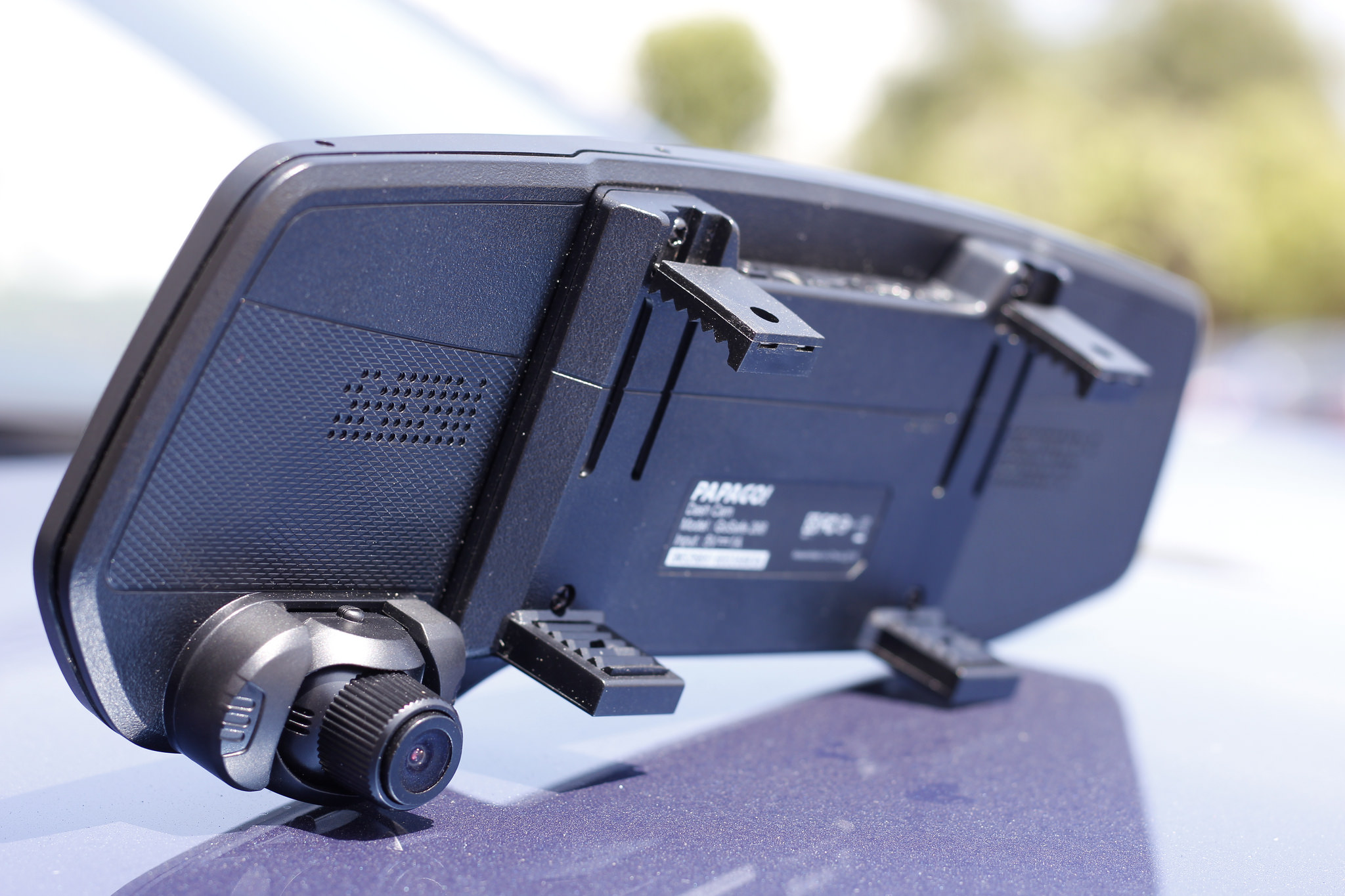
- Sony Exmor Sensor
- 1080p
- 2.7” screen
- 135° FOV
- Optional GPS
- Driver/parking assistance
The mirror styling is aesthetically pleasing, with a clean look. The problem with the GS268 is that the method for attaching it over the stock rear view mirror is a spring-loaded bracket, and it does not extend enough to fit over a couple different car mirrors we tried. The camera itself is actually quite small in form on this one. The screen is in the far side of the mirror from the driver, which seems like it would be better suited on the closer end for easily navigating through the options and viewing footage.
The GS 268 doesn’t quite live up to its companions from Papago!, as the image quality isn’t as sharp and the detail is harder to pick up in ideal situations. Night recording isn’t too bad in the headlight beam, however the sides of the picture are much darker. The lower FOV is noticeable, and while the quality isn’t bad for a dash camera, the bar was set pretty high with the GS 30G and GS 350 Mini.
Putting it all together
Through all the testing there are clearly some cameras that come out with more features or high quality picture, but what it all boils down to is the actual user preferences. Is driver assistance or a standalone editing suite a plus? Is a good balance of day/night visibility preferred or is optimal daytime driving good enough? At the end of the day, balancing the cost with the specific needs the driver needs to feel safe is a case-by-case basis, but when all the chips are down having protection on the road is vital.
Featured in this article:
Wheel Witness HD PRO PLUS- $124.99
SoundLogic XT Slimline- $23.99
Papago! GoSafe 350 mini- $129.99
Note, all prices and products are accurate at the time of article publication, although some may have changed or are no longer available.
